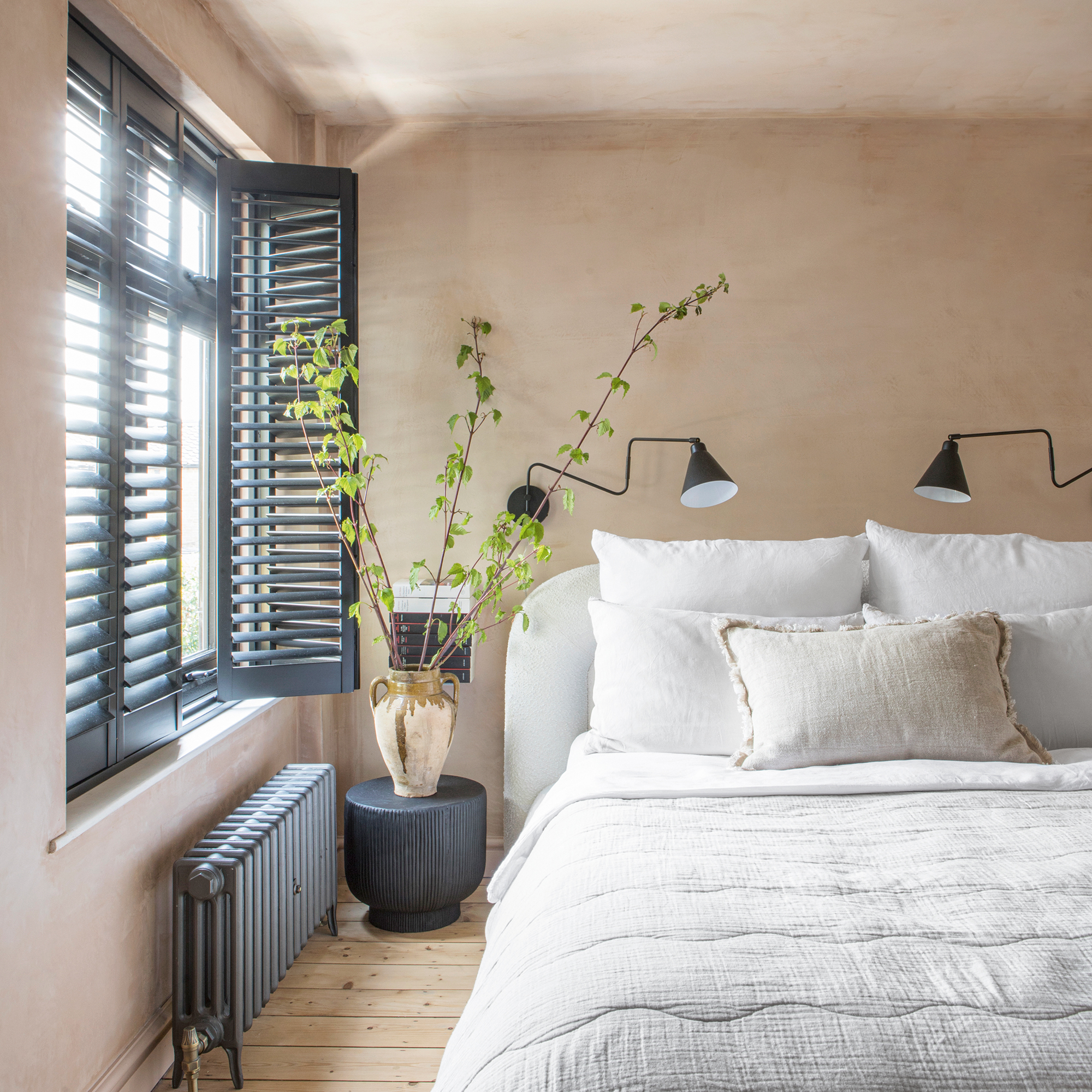
Paint is one of the best and also most affordable ways to update any room in your home whenever you feel like your space needs a refresh. Whether it’s a new colour or a technique, any of these creative paint ideas are sure to inject character into your home and make a statement, however big or small.
While it might not be the most renter-friendly DIY project, we recommend always checking with your landlord whether it was alright to paint the walls, either when you’re moving in or when you’re considering painting the walls. You might be surprised at how many landlords don’t mind, as long as you paint them back before you move out.
For many of these, you don’t even need to paint the whole room – an interesting here and there is sometimes all it takes to create a showstopping feature that will draw the eye.
Paint ideas for every room
‘Trying new paint ideas is like anything you’ve never done before, you just have to take a leap and get stuck in,’ says Marianne Shillingford, creative director and colour expert at Dulux.
And we couldn’t agree more. So grab your brush and paint roller, choose your paint shade and go for it! You can always paint it back or go for another paint idea at a later time, it’s not permanent.
1. Try your hand at colour washing

Have you heard of colour washing? Not to be confused with colour drenching, colour washing is a paint technique that creates a weathered, textured finish that uses thinned-out paints of slightly different shades mixed with glaze, covering the walls with multiple thin layers.
‘I love that people are starting to experiment more with techniques such as colour washing,’ says Caroline Woolmer, head of product design at Lucie Annabel. ‘Colour washing introduces depth and texture to a space.’
2. Make the ceiling a focal point
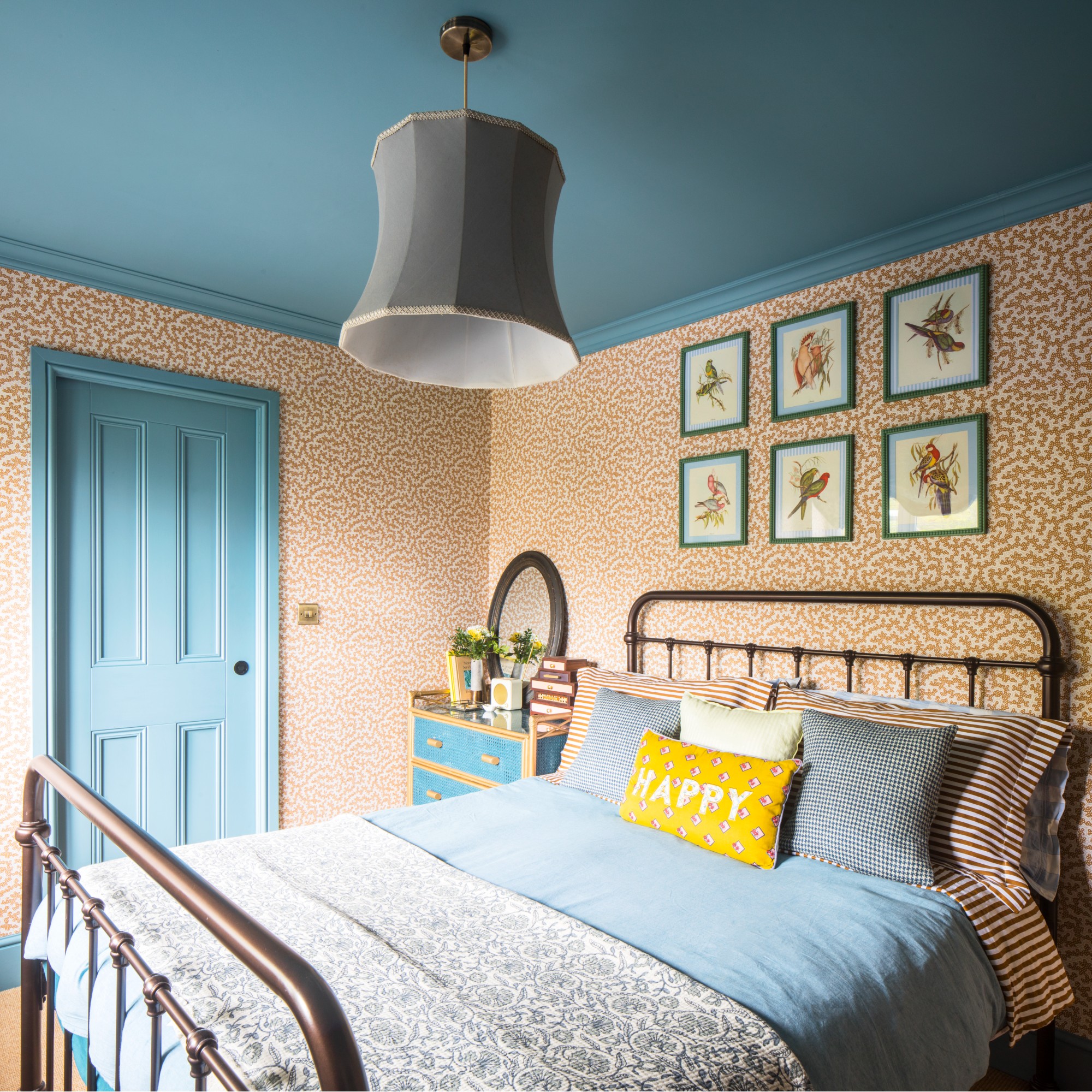
One of the biggest paint trends of this year is bringing the gaze upwards by covering the ceiling in a contrasting, standout shade. The ‘fifth wall’ will not be neglected any longer or left plain white! Instead, it demands our attention.
‘Adding colour to the ceiling is becoming one of my favourite and almost instant room transformations. The norm is to have a standard, white ceiling so it feels deliciously rogue painting a colour up there. It also offers endless opportunities for being more creative with techniques like a painted sky with clouds and birds or capturing the power of sunshine beaming down on you with a simple painted yellow circle around a ceiling pendant fitting,’ Marianne at Dulux says.
3. Give double drenching a go
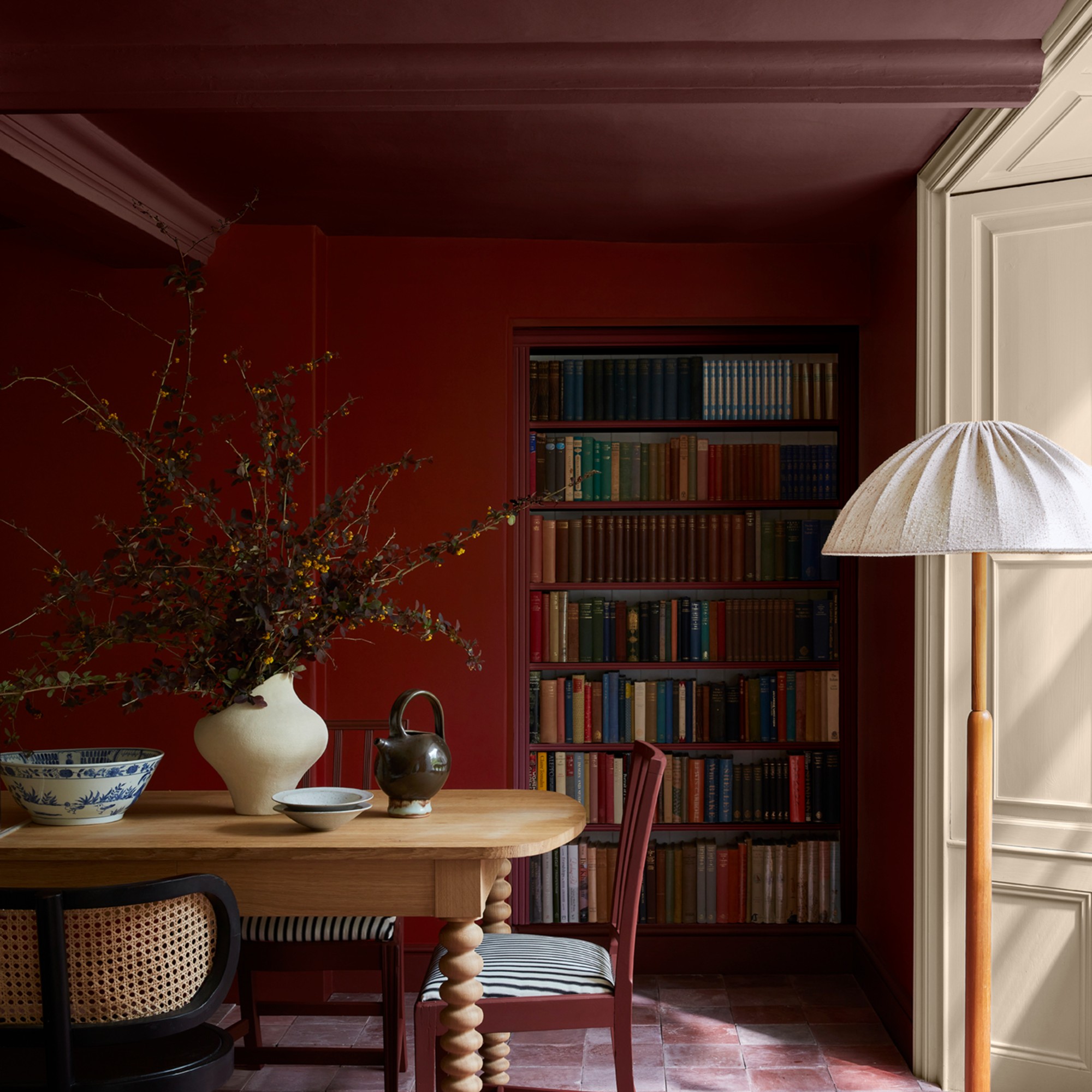
Colour drenching has become so popular over the last couple of years that now there are new twists being made on the home decor trends. One of the standout ones for 2025 is double drenching.
‘Double drenching is a more sophisticated evolution of the colour drenching approach,’ explains Ruth Mottershead, creative director at Little Greene. ‘Rather than enveloping a space from ceiling to skirting and every surface in between in one single colour, double drenching utilises two or more related colours to drench an interior. More complex to achieve, the double drenching approach works best when equally powerful colours that vary in hue rather than tone are used.'
She continues, ‘For example, Mid Azure Green, a splendid, sophisticated green-blue teal colour, can be combined with vibrant Deep Space Blue and indulgent indigo-hued Dock Blue which is a slightly greener shade than a traditional navy. These colours work together in a drenched interior to elicit both contrast and harmony, their cohesion formed by their shared pigments and their contrast by their varying undertones.’
4. Look to the colour wheel for inspiration
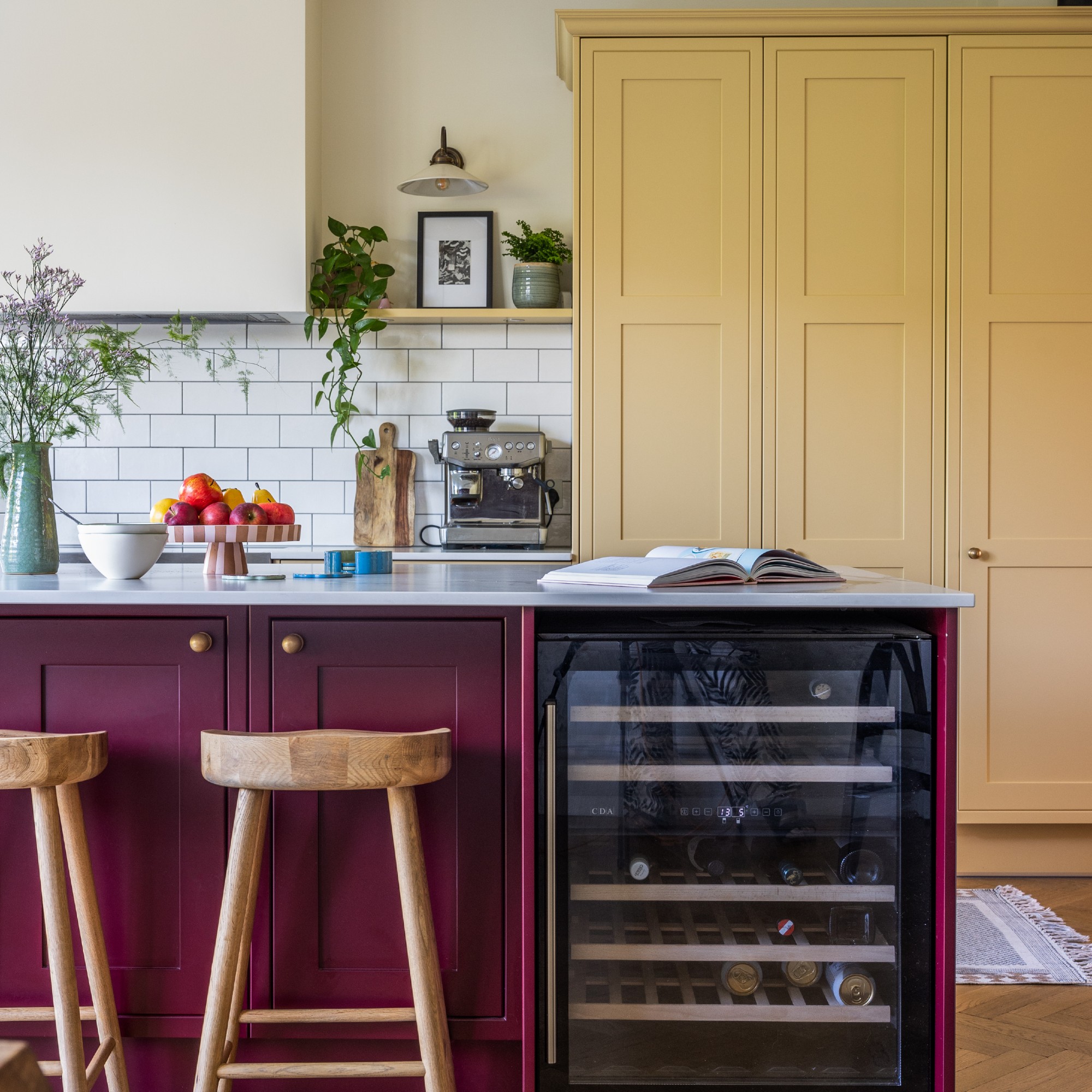
The colour spectrum is the best source of inspiration when thinking of both the most complementary and surprising colour combinations – and that goes for paint, too. But if you don’t know how to use the colour wheel, Jordan Larmour, interior designer from Larmour Studio, has some tips.
‘Opposites attract! Pairing colours from opposite ends of the spectrum creates a bold, high-energy contrast. Think rich coral pink with a punchy turquoise or a zesty lemon yellow against deep violet. But colours that sit side by side on the wheel flow naturally together, creating an effortless gradient. Picture sunset-inspired hues like peachy orange, warm terracotta, and soft blush pink – perfect for a cosy yet dynamic space,’ he explains.
Lastly, there are triadic colour combos. ‘A lively, balanced trio of evenly spaced colours on the wheel. Imagine a playful mix of deep forest green, warm goldenrod, and a vibrant periwinkle blue – fresh, youthful, and full of personality,’ Jordan says.
5. Paint a wall pattern or a mural
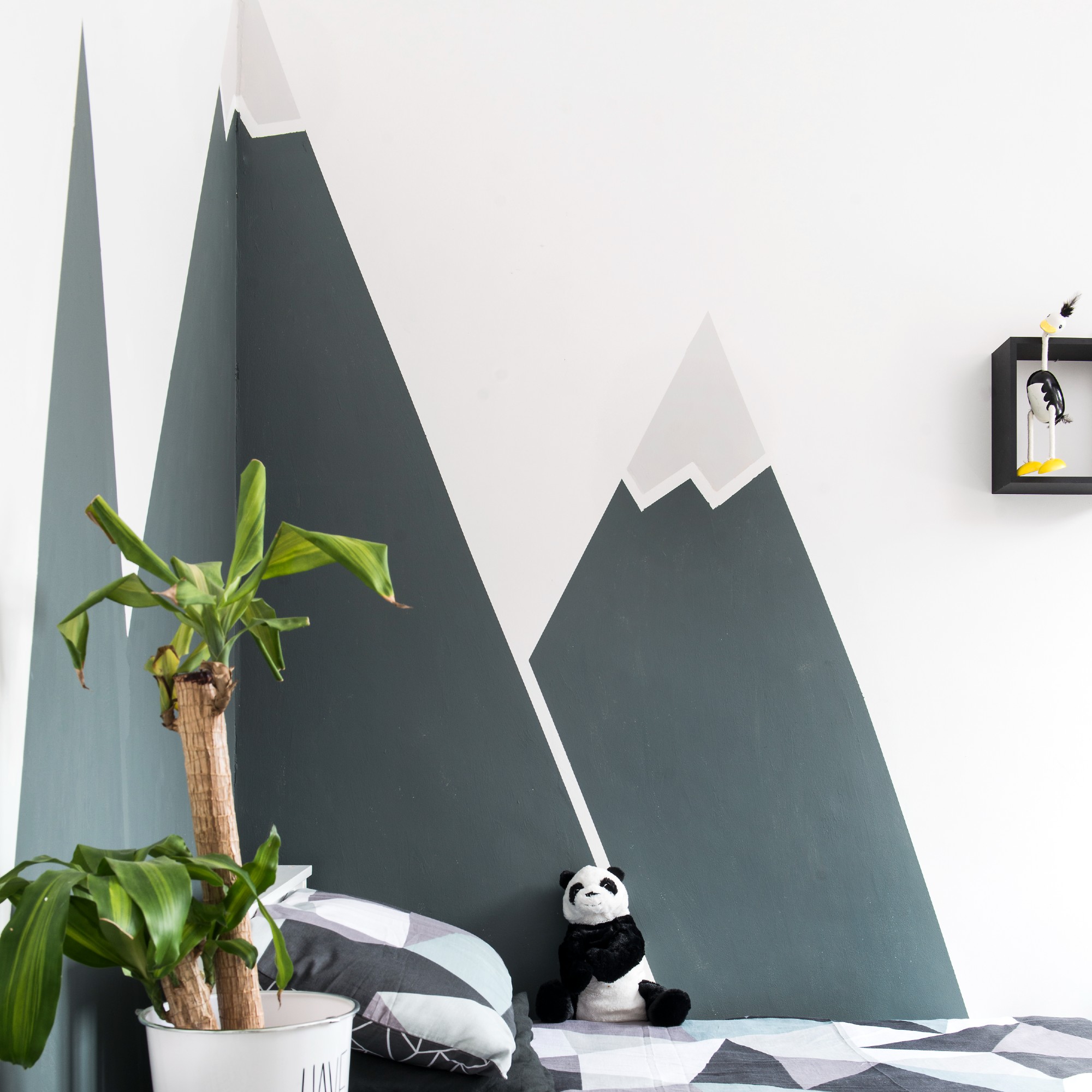
Trying your hand at freestyling a pattern on your walls without the use and the perfection of masking tape is currently a popular approach as dopamine decor and putting one’s personal stamp on their home is now the priority. So why not give it a go and have a bit of fun in the process?
‘Murals are a personal favourite paint technique of mine - no surprise I love to paint - but it’s just such a fun and expressive way to decorate your home and end up with something totally unique and one of a kind to you,’ Marianne at Dulux says. ‘It doesn’t have to be complicated, it could be a pattern or word created with decorators masking tape. Hand-painted details and folk art techniques are so popular at the moment so don’t be put off thinking you need to be an artist to be able to paint a mural. The beauty in anything painted by hand is definitely in the wobbly bits and simple stencils are easy to paint and look fabulous.’
6. Update your kitchen cabinets

Painting your kitchen cabinets is one of the best and easiest ways to update your kitchen colour scheme – and to give yourself the look and feel of a brand new kitchen without having to spend the money.
‘Painting kitchen cupboards is a cost-effective and easy way to give the kitchen a makeover and refresh,’ says Jimmy Englezos, senior brand manager from Ronseal. ‘Some might want to do this as they might have grown tired of the original colour, or it doesn’t match their aesthetic anymore and painting them is more cost-effective and quicker than replacing the cupboard doors completely. It’s also a great way to incorporate more colour into a plain space.’
7. Make your own frame
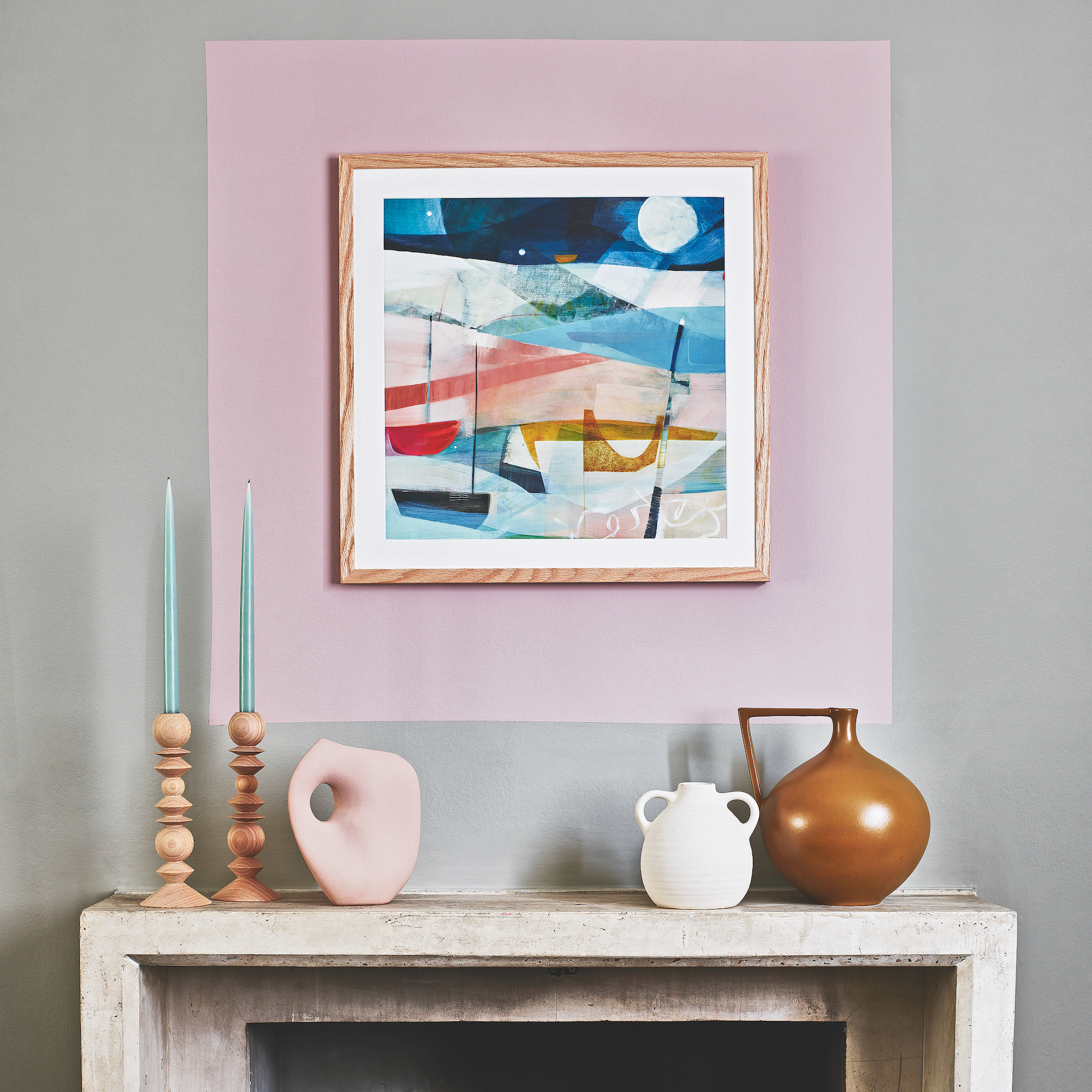
Framing art can be expensive, so why not use paint instead? Whether your art is a little bit too small for the space or your frame is looking lacklustre, creating an additional border with paint will elevate the area and put your print at centre stage.
'Occasional moments of bold colour also create the opportunity to draw attention to small details in a room,' enthuses Catharina Björkman, interiors expert at Contura. So if you have a favourite painting or nostalgic photograph you want to be noticeable, paint will help to achieve that.
This is also a fun way to play with colour. You can pull out a colour from the art for the makeshift frame or even contrast it completely, either is guaranteed to be eye-catching.
8. Try limewashing
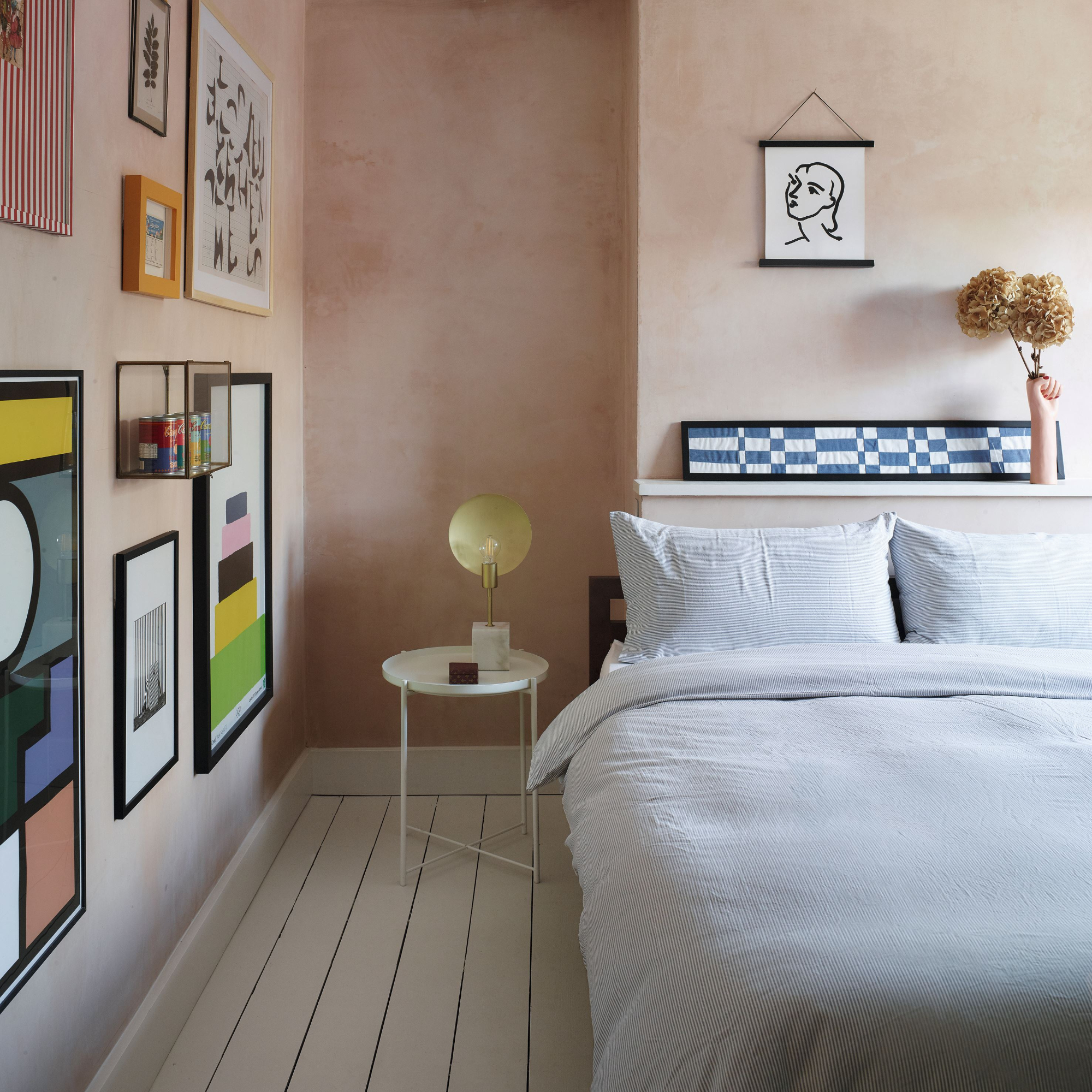
Limewash is one of our favourite paint ideas and believe it or not, you can actually DIY it with this TikTok hack. There are also a number of premade limewash paint options. Either way, it immediately adds a cosy and enveloping look to any room and what is often some much needed texture. Similar to colour washing, limewash dates back to the Roman times and uses specifically limestone, natural pigments like clay and water.
‘Limewash walls have a chalky texture and soften standard paint colours, giving a warmer and more natural finish,’ suggests BoConcept’s marketing manager, Emma Cottrell. You can even ‘layer coats of paint to create a deeper colour and texture.’
And with reports that limewash paint can help you sleep better, it’s definitely one paint idea to try out at some point.
Farrow & Ball is one of our go-to paint brands that never disappoints. And they do limewash paint, too. This neutral creamy shade with a grey undertone is one of our favourites.
Bauwerk Colour is a paint brand that specialises in the sought-after limewash finish. With a wide range of colours to choose from available, this earthy pink named after the Moroccan city is one of our top picks.
If the trending earthy colours is what you're after then this orange terracotta shade of limewash from Rust-Oleum will surely float your boat. It sure does ours!
9. Add a pop of colour inside shelves and cupboards
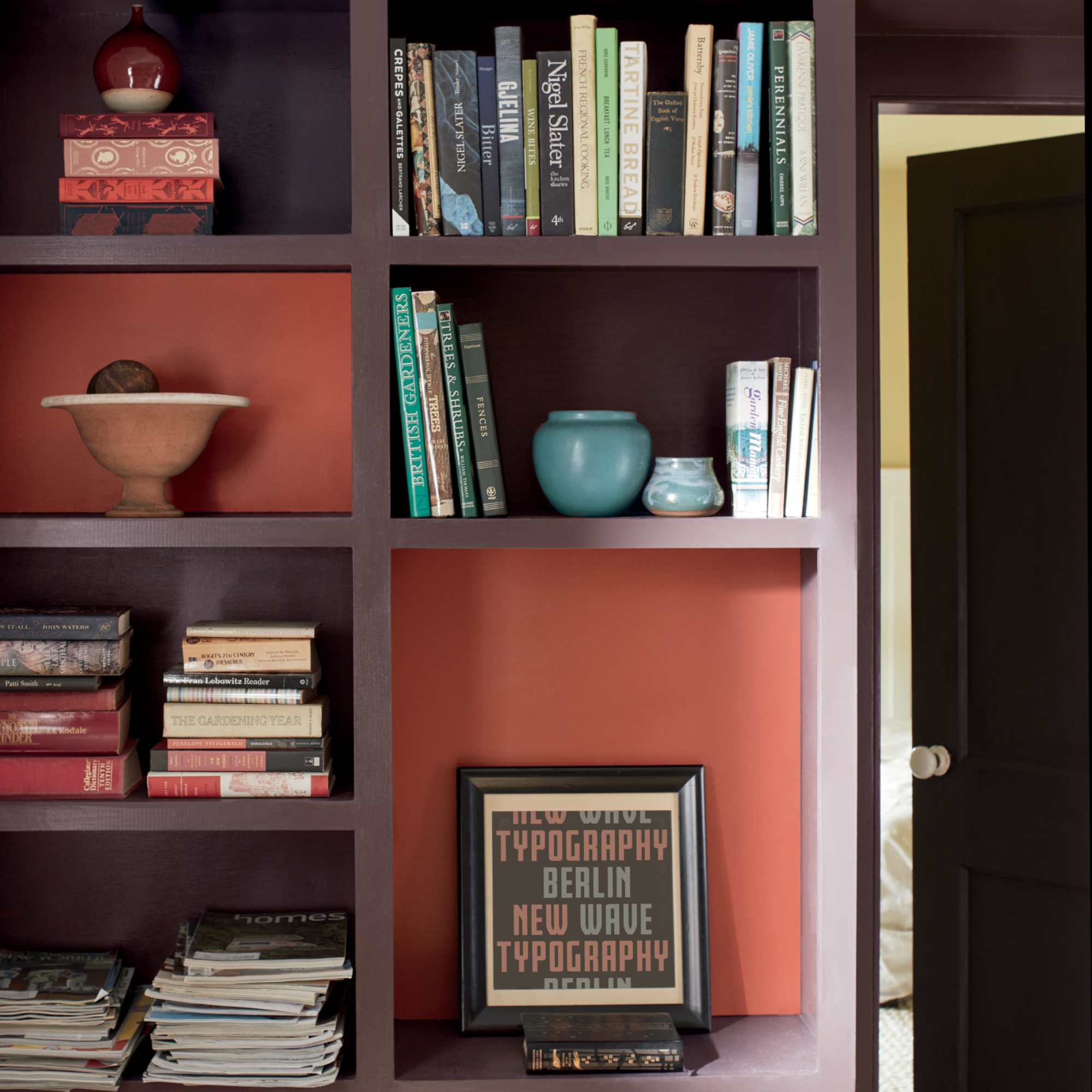
Whether you’ve got an otherwise more neutral design or are looking to complement a more colourful room, something as simple as painting inside shelves and cupboards can add an interesting feature and focal point to your room.
You could opt for a single shade or get really creative and add some fun designs inside. Just make sure to check what material your cupboard or shelves are made out of, to ensure you pick up the right paint for this easy DIY project.
10. Embrace the colour drenching trend
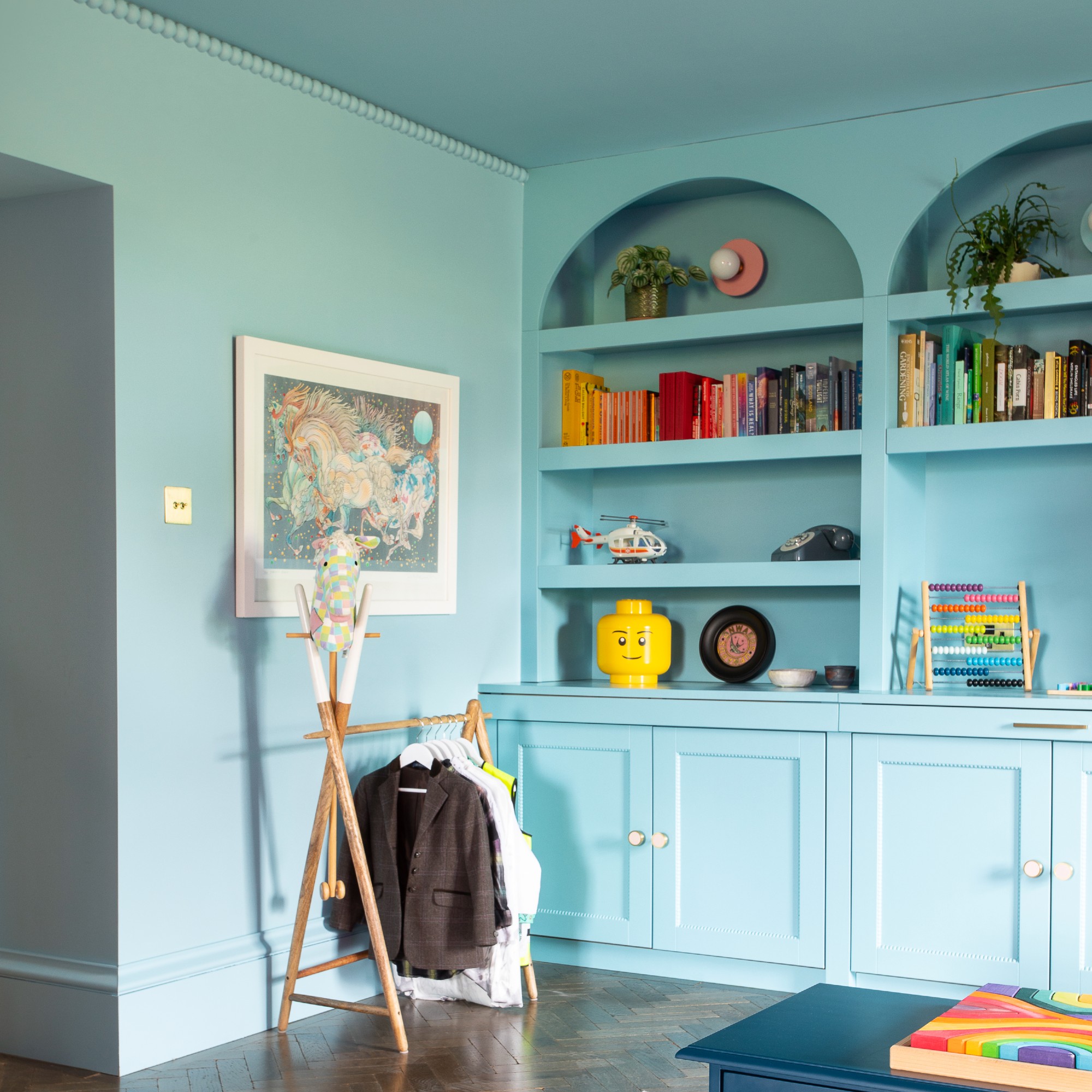
If you're happy to take paint upwards onto the ceiling, have you considered the colour drenching paint trend? Personally, we can't get enough of it and if you fancy trying it out in your own home, it’s one of the easiest paint ideas as essentially you’ll just be painting everything in the room - from the walls and skirting to woodwork and even the ceiling - in the same hue.
'Colour drenching is a great painting technique if you want to create a unified, immersive effect in a space,' says Lucy Steele, Valspar's paint and interiors expert. 'The trend consists of choosing one colour and using it throughout a room across different surfaces and features, from the skirting boards to the ceiling. The technique can be used in any room of your home, even bathrooms, and can work with most colour schemes and interior styles. It’s particularly effective in small spaces, as it minimises visual boundaries and can help to make the space feel larger and more cohesive.'
11. Add a border to windows
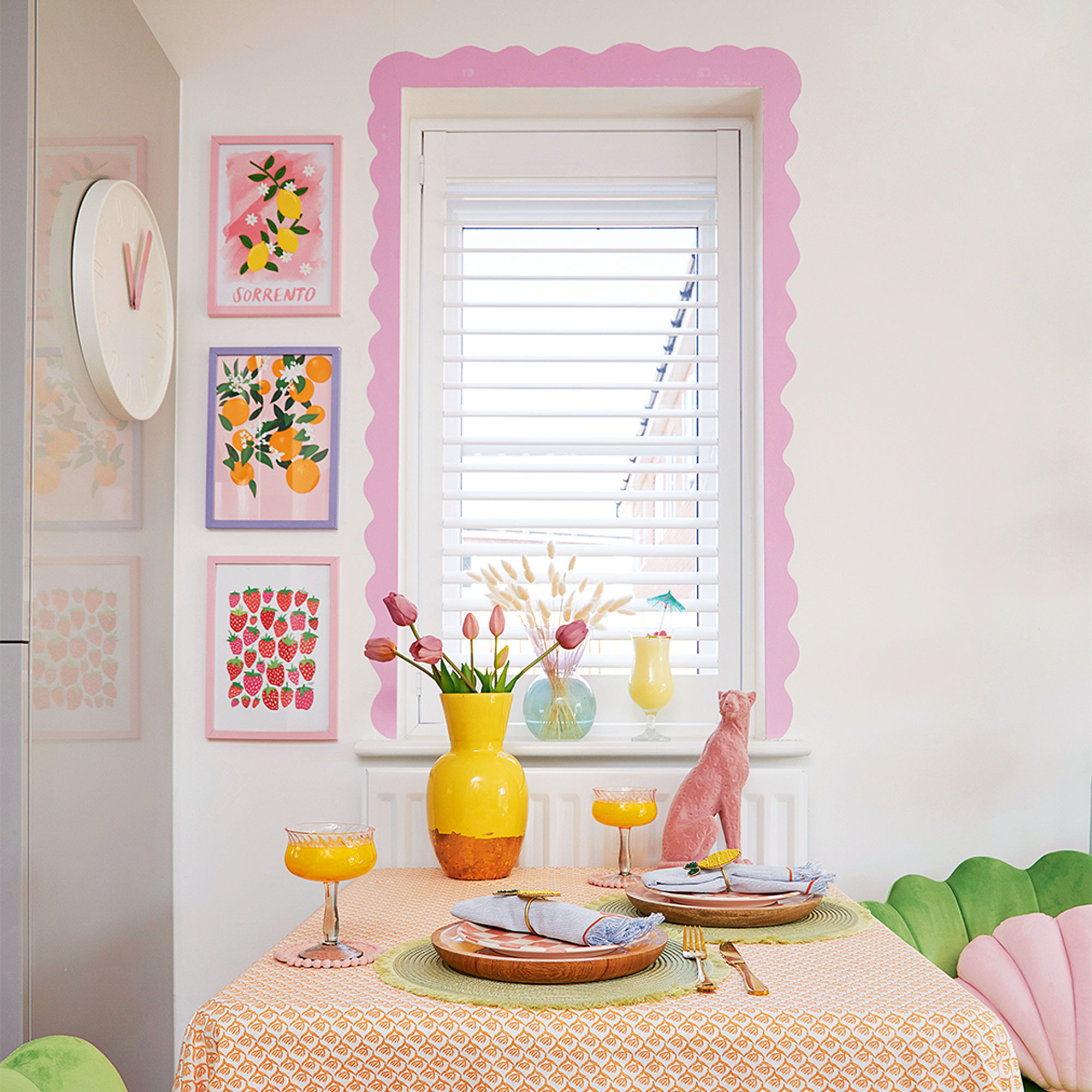
As well as framing art with paint, look to the structural frames you already have in your room - windows. They lend themselves perfectly to adding a fun border with paint and help to draw attention to the light source.
'To enhance a connection with the outdoors, paint the window frames the same colour as the walls,' advises interiors expert Catharina at Contura.
'This directs your gaze towards the view as opposed to the window, which is now uninterrupted by the shock of a different colour frame and can be incredibly peaceful for the mind. Connecting with nature is vital for wellbeing, so allowing your home to blur into the view from the inside out is a great way to start.'
12. Transform your kitchen or bathroom by painting tiles
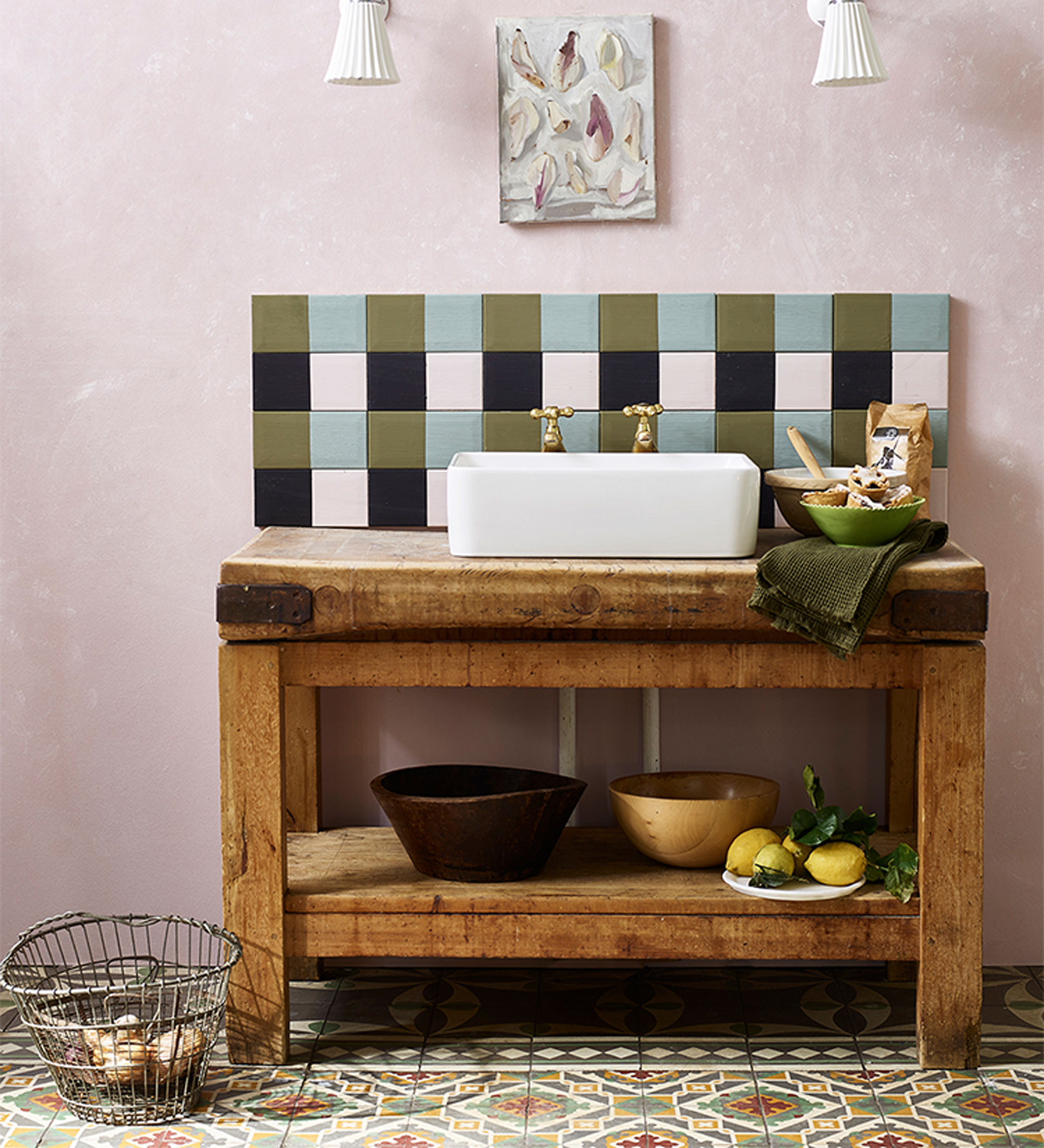
If you’re looking for budget friendly decorating ideas, you can completely transform the look of your existing kitchen or bathroom simply by painting the tiles. ‘Painting existing tiles can breathe life into your kitchen, which is not only cheaper, but also less time consuming than ripping out old tiles and starting from scratch,’ says Looeeze Grossman, founder of The Used Kitchen Company.
For example, ‘turning tiles from white to green can transform the whole kitchen, and is a trend that is proving popular in a lot of celebrity kitchens,’ Looeeze continues. When it comes to painting kitchen tiles and how to paint bathroom tiles, we’ve got step-by-step guides to make doing both a complete breeze.
13. Match woodwork to wallpaper
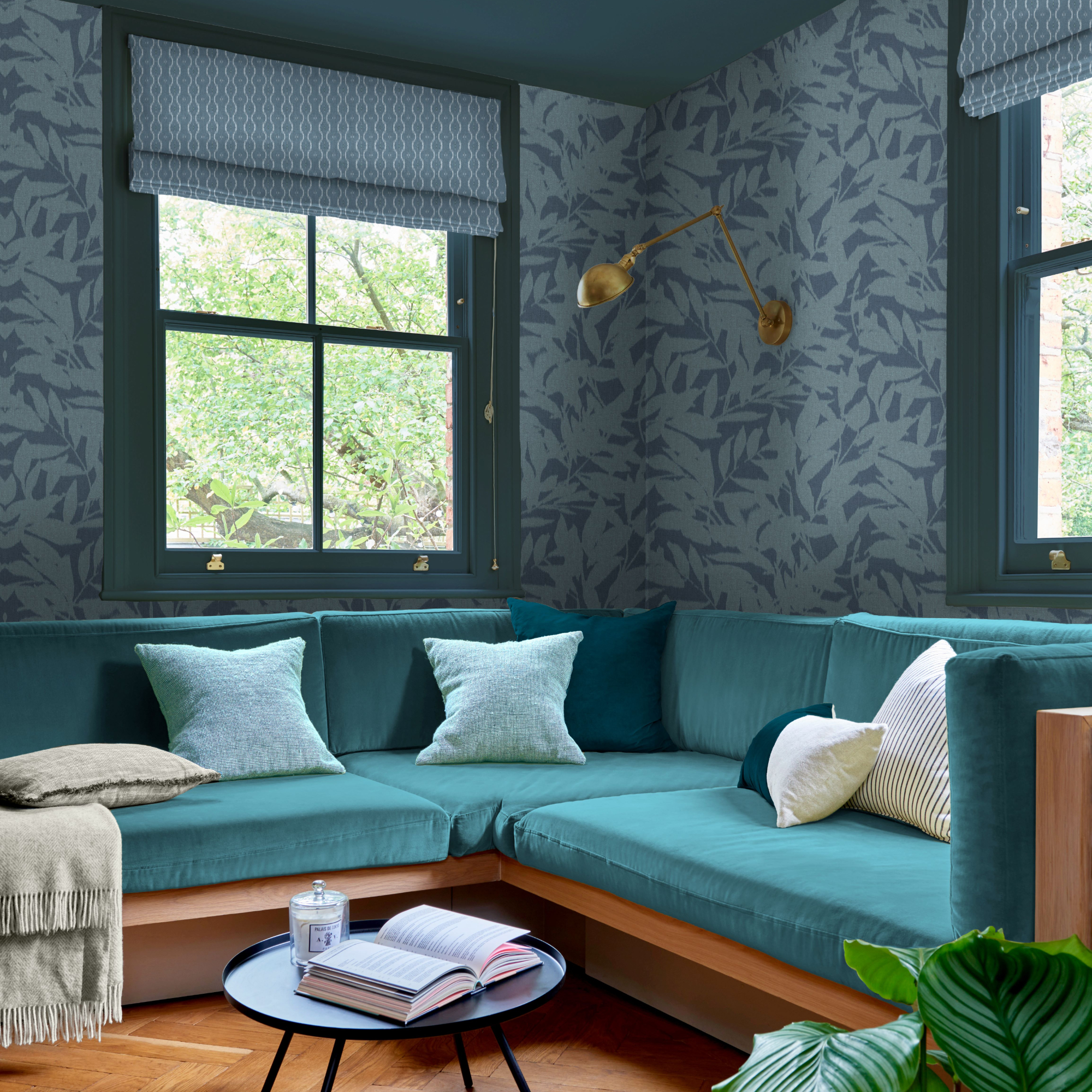
‘Painting woodwork the same colour as the wallpaper in a room has an instantly opulent effect,’ according to Ryan McDonough, interior design expert at MyJobQuote.co.uk. ‘The harmony between the two, particularly when the paint is a rich, deep colour evokes a curated and designer feel,’ he explains.
Even if you only use an opulent wallpaper on one of the walls in the room, this can be an especially great idea if you’re looking to make a smaller room feel cosier with more harmony.
14. Ombre it up
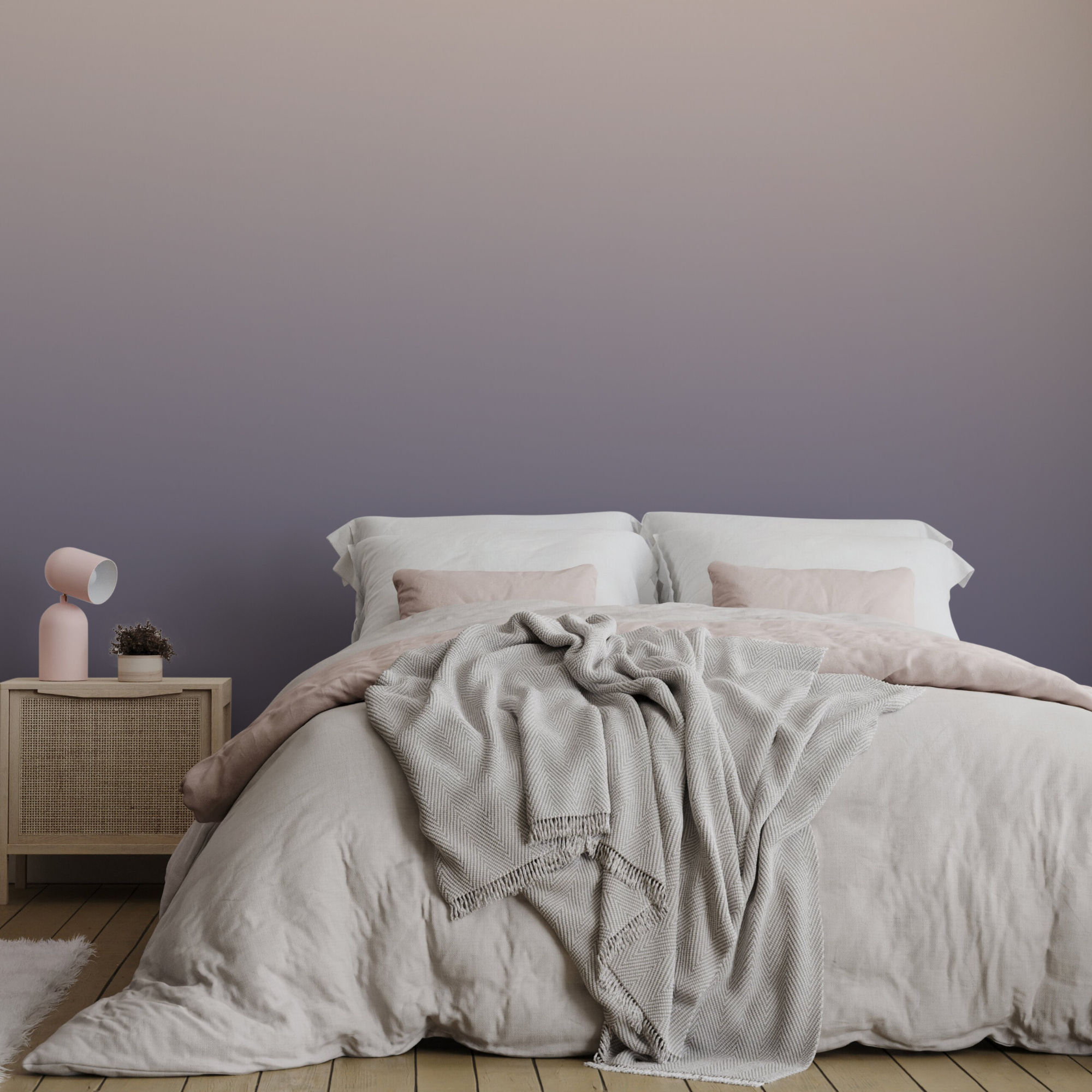
The ombre paint trend is another one of our absolute favourites, with it creating a calming and inviting vibe. And you can even do this yourself, if you’re partial to a bit of DIY. Essentially all you need to focus on is subtly shifting the colours from light to dark – or dark to light – depending on your preference.
It looks particularly impressive as a feature wall in a bedroom or to add a pop of interest to an otherwise muted living room.
15. Make the most of ceiling height

When you think of two-tone walls, you might think of creating a line of difference at the halfway point. However, extending that point upwards to the top of the room is a clever way of making a room feel brighter, and maximising the ceiling height commonly found in period properties.
'It's important to consider the features you want to be the hero of the room and use bold, rich colours to highlight them,' says Philippa Radon, C2 Paint's colour and design specialist.
'Many period homes have a picture rail around the top of the walls a little lower than the ceiling,' adds interiors expert Catharina at Contura. 'Often, the wall colour stops at this point, but it doesn’t have to. By painting up over the picture rail, you can actually accentuate the height of the room.'
16. Make a memo board
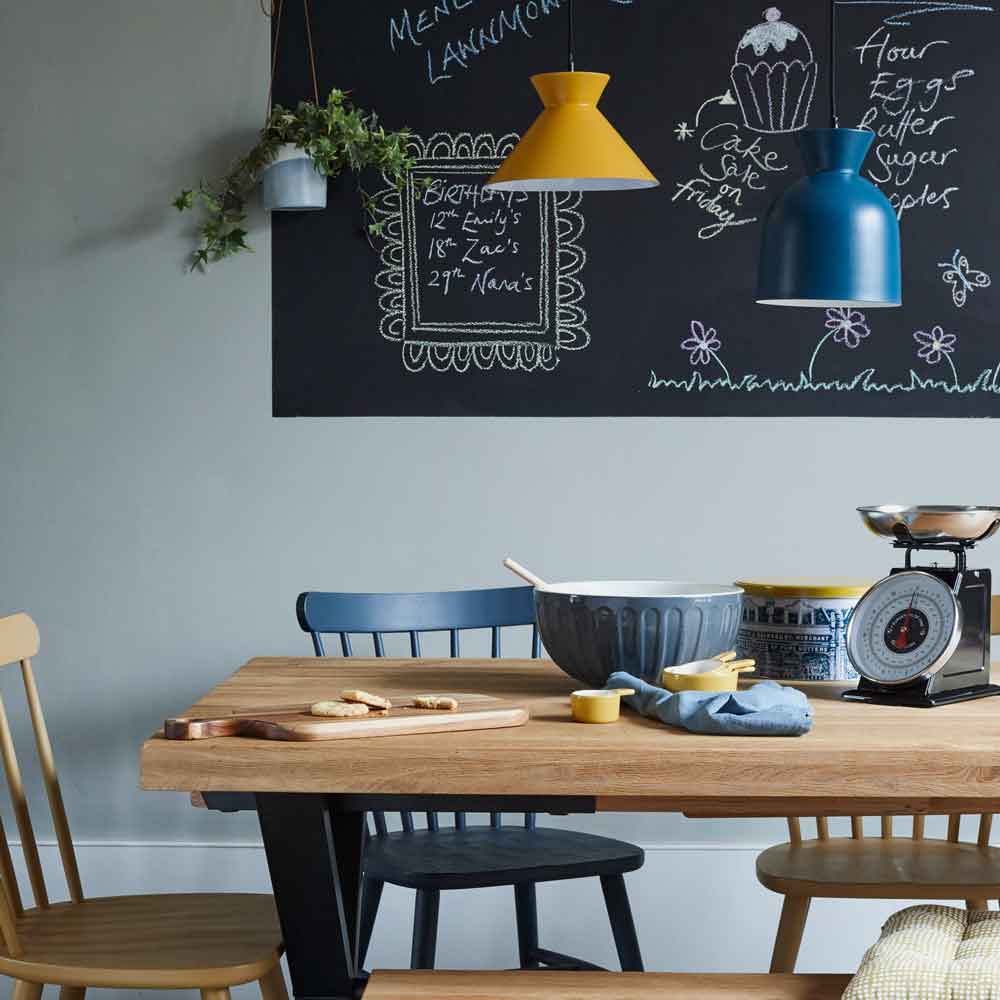
Some of the best paint ideas involve ample colour, but personalisation is one step up from this. Chalk paint is great for a family kitchen or children's rooms as it creates a spot for getting creative or making note of family memos.
You can either add a chalkboard design straight onto a wall or onto a board to hang up if you want a less permanent option. Either way, it's a fun way to make a room feel entirely personalised to your family and take the place of a notepad and pen.
17. Don't forget the door
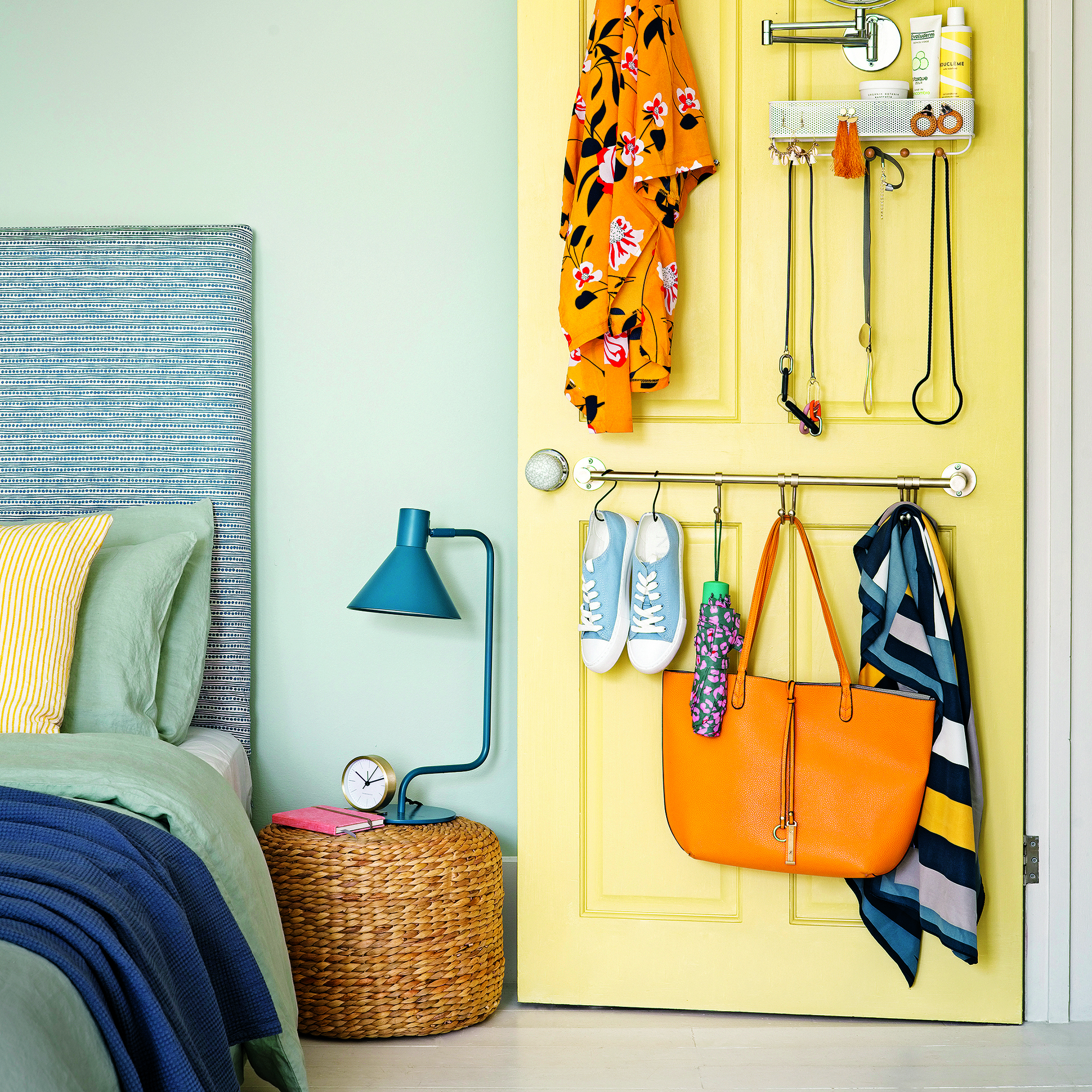
When planning out the paint ideas for your home, it's easy to focus on the walls and forget about other areas, like doors. Adding a pop of colour to a doorway is a great way of bringing in a feature shade that you can then match with smaller accessories. It's a smaller surface area than a whole wall, so you can easily go all out.
'A great way to add colour is to do it in small doses or create ‘moments’ of colour throughout your home,' adds Catharina at Contura. 'Painting the inside of the utility room, airing cupboard or even a wardrobe with a bright print is a fantastic way to have a little fun with the space and express personality.'
Painting the inside of the door creates a hidden treat that is joyful for those inside the room but doesn't interfere with the rest of your home decor – and it's likely one of the places you're forgetting to paint but really shouldn't.
18. Give your radiators an update
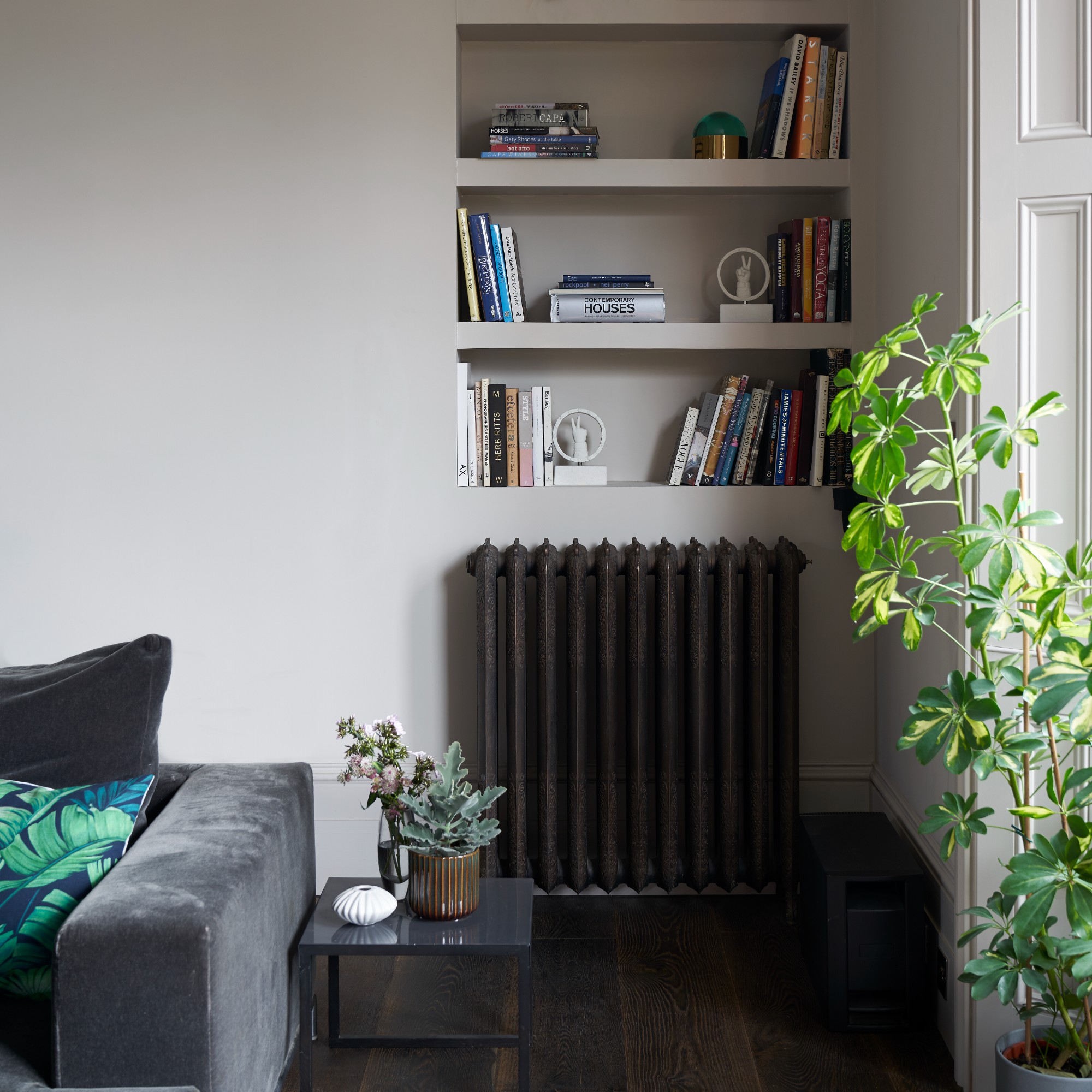
While radiators very much serve a function in our homes, they’re not always the most exciting feature in a room. But you can instantly give them a style upgrade with a spot of paint.
‘Of course, you have to use a product that is suitable for radiators but there are plenty of bright colours to choose from if you want to highlight your radiator,’ says interior design expert Ryan at Myjobquote.co.uk.
Or ‘if you prefer to make the radiator blend in rather than stand out, paint it the same colour as the wall.’ Plus, we’ve got a step-by-step guide on how to paint a radiator, which will definitely come in handy.
19. Zone off a WFH space
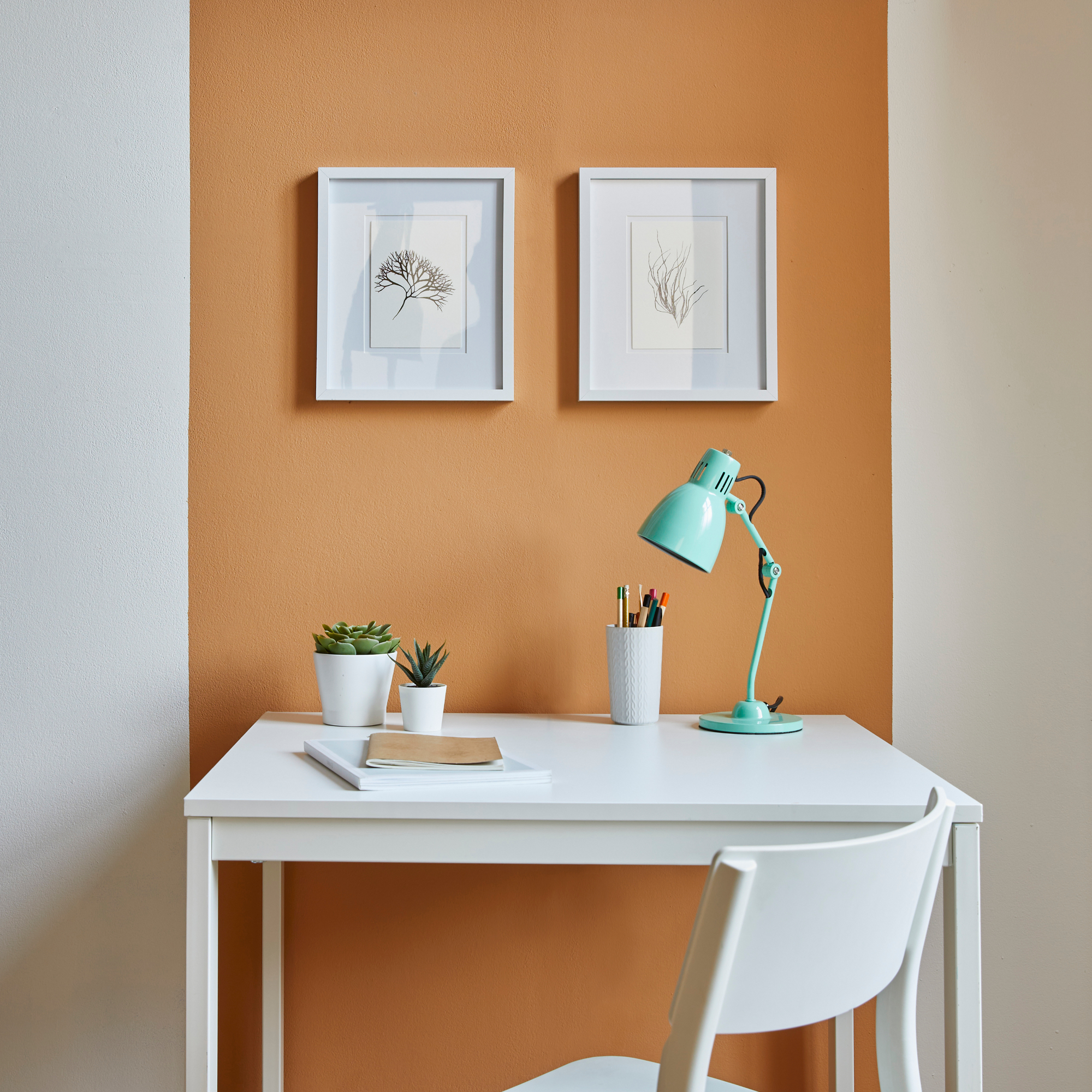
With many of us still working from home, even if it’s just for a few hours or days a week, creating a dedicated WFH space can help you to disconnect and remove yourself from the work mindset at the end of a long day. And Amthal Karim, head of design at Furniture And Choice, recommends using black to do this.
‘You don’t even have to paint the whole room, just have one accent wall and paint the shelving and desk in dramatic black to match,’ she suggests. ‘This design idea zones off your office space visually from the rest of your living room,’ or space. Alternatively, you could pick a fun pop of colour to add an interesting touch to an otherwise practical area of your home.
20. Focus on furniture
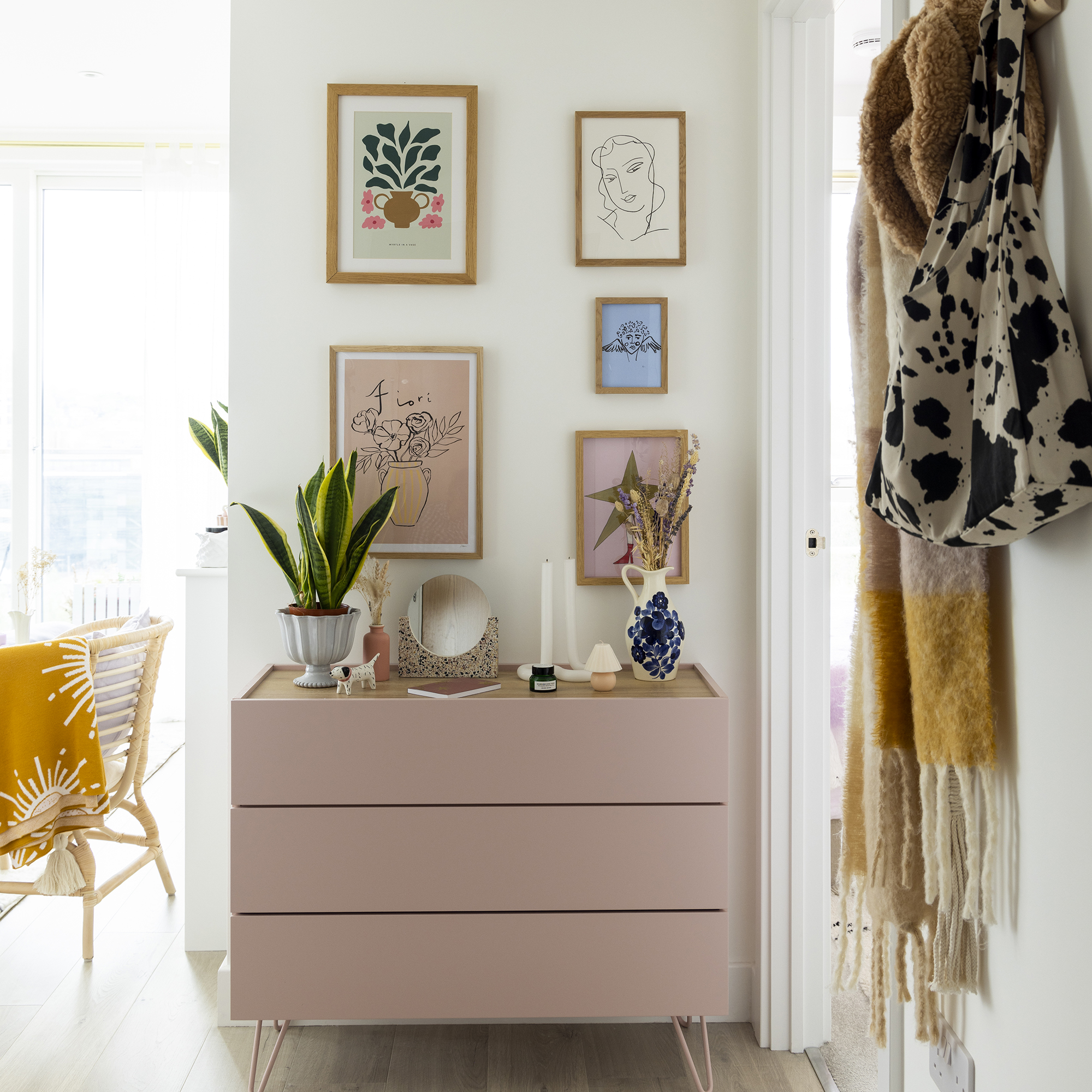
Paint isn't just reserved for walls - if you want to give your home a quick refresh but don't want to commit to colourful walls, then using up leftover paint on furniture is a handy route to go down. Depending on the size of the piece you want to revamp, you can make use of tester paint pots too making it a quick budget DIY project, and a quick way to upcycle furniture.
'Walls are not the only thing to consider painting in a room. If you want to add a pop of colour but not too much, try painting just the bookcases or a focal piece of furniture, and pair it with more subdued walls,' says Philippa at C2 Paint.
Plus, if you're a renter then painting affordable furniture nabbed with home decor discount codes will help your house to feel like a home, without potentially annoying your landlord with changes to the walls.
21. Give panelling a tricolour freshen up
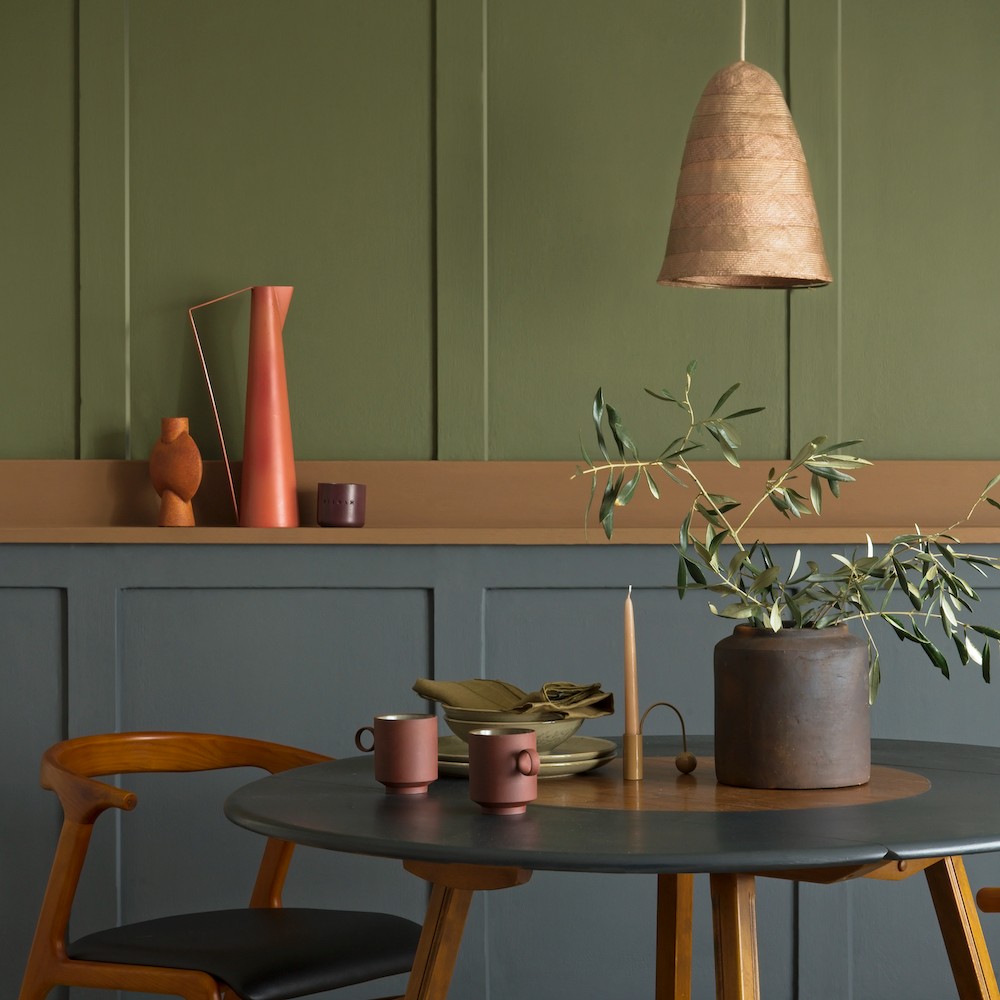
Separate panelling with the addition of a shelf along its length. This allows you to separate colours just like you would above and below a dado. Choosing colours that are tonally the same but from different colour families works well. Think about how to use the colour wheel – a grey, a brown and a green blend perfectly.
The addition of a painted up-cycled table, in a darker grey, adds to the look. Leave a fun circle of its original colour in the centre.
22. Go for vertical colour blocking
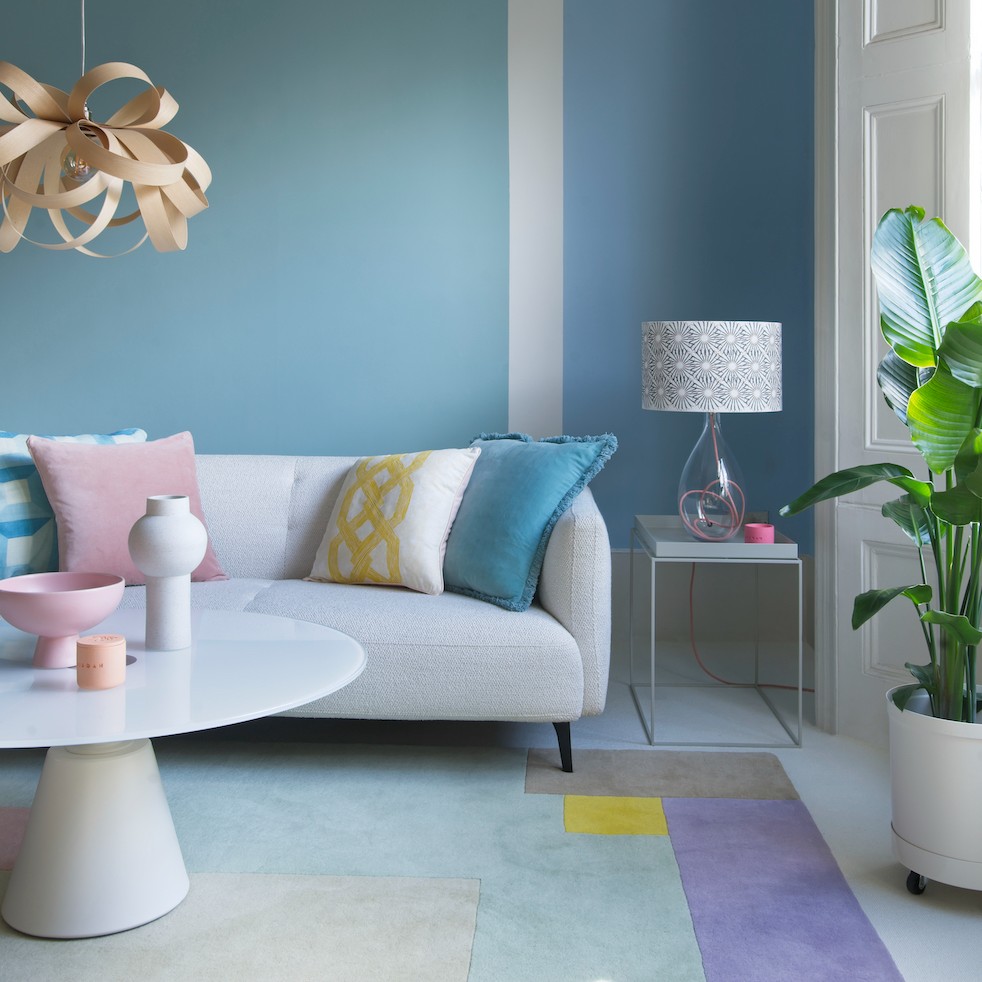
Create a colour-block wall of uplifting blues and greens by dividing the area with an off-centre stripe of white. Choose colours from the same colour spectrum, and look at colours that sit next to each other to create a sense of balance.
Continue the colour blocking living room paint idea through the scheme with graphic rugs, cushions and bold accessories.
23. Create a painted fireplace focal point
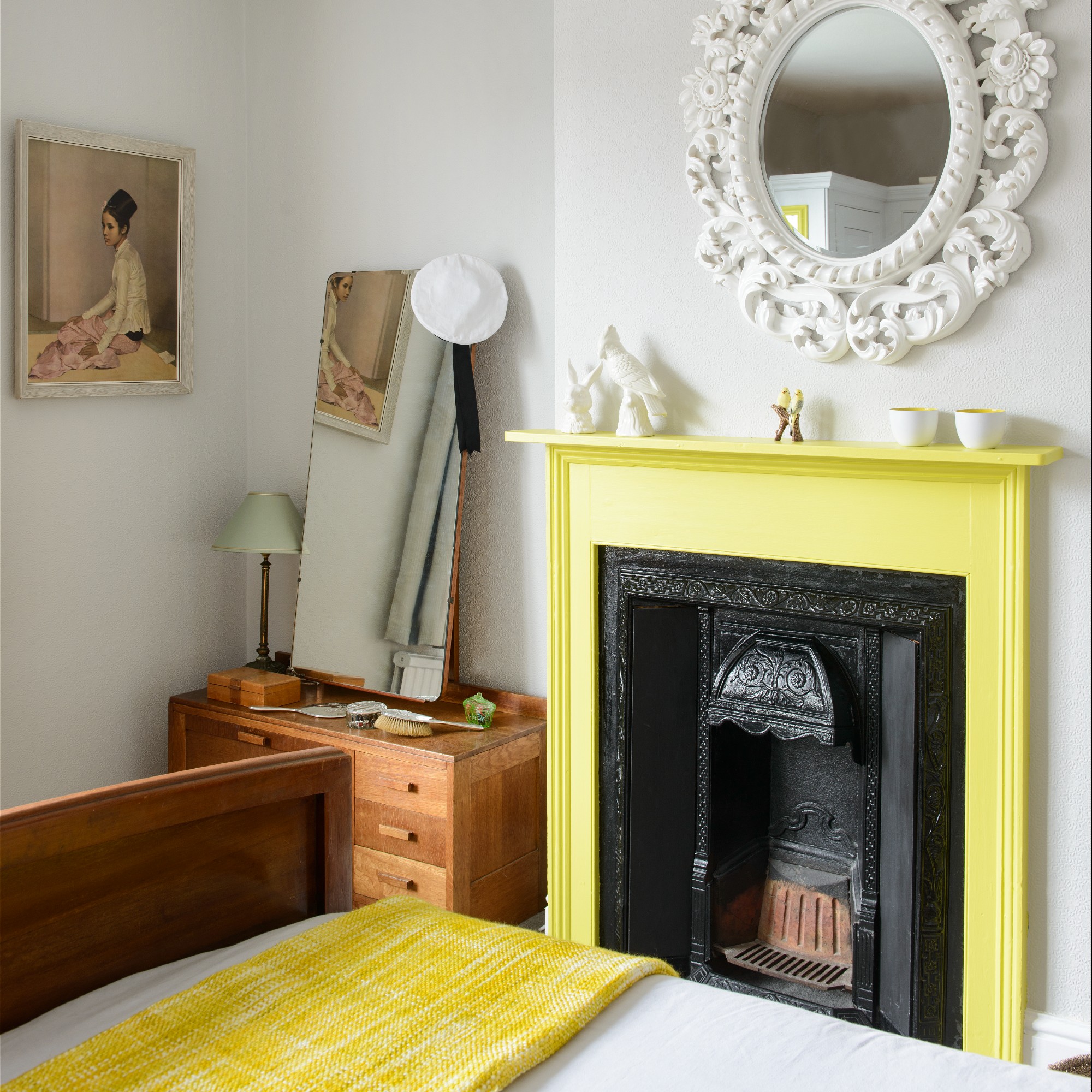
Paint a fire surround a bright, uplifting colour. This idea works brilliantly to add a pop of colour to a room. Use an eggshell paint so that the surfaces are easy to dust and clean.
Co-ordinate the scheme by painting log ends. You could even paint a circular canvas a flat colour too as an alternative to hanging wall art. Add colourful candles and vases to create a fun mantel display.
24. Try ombre stripes on shelving
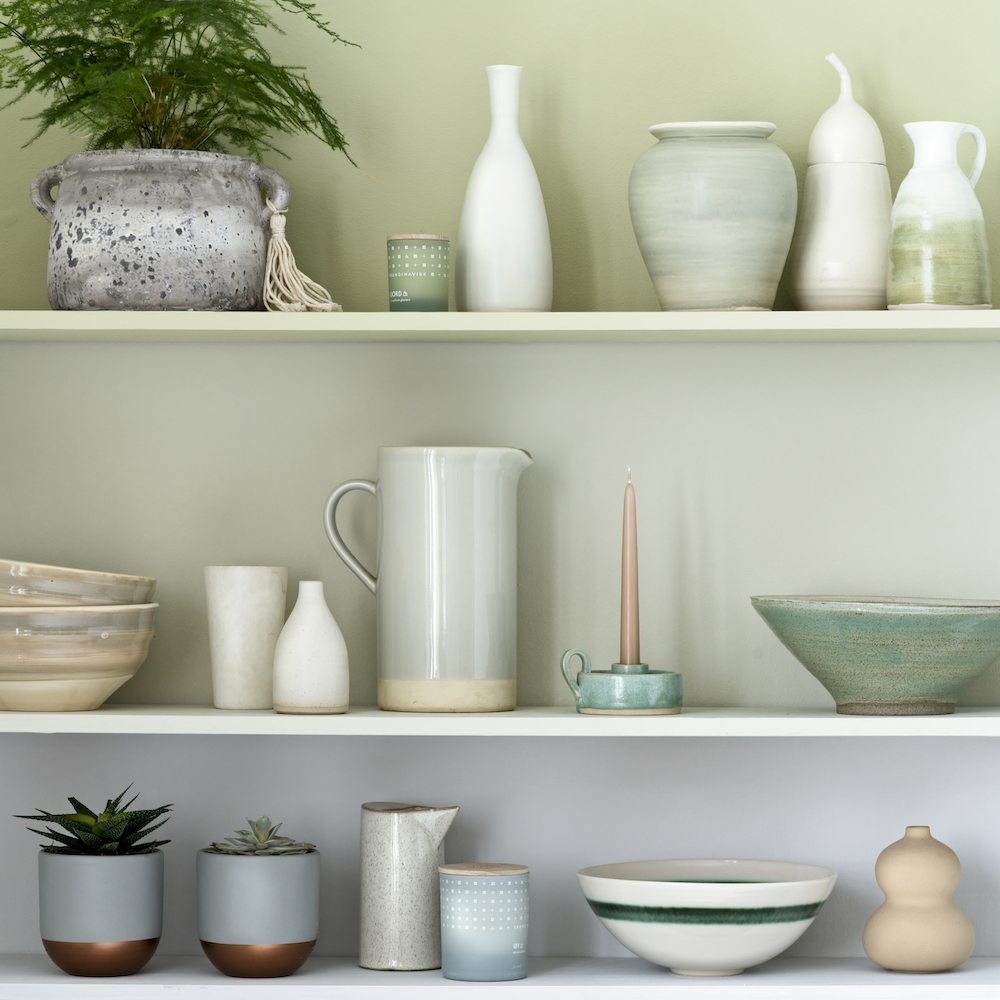
Follow the trend for faded ombre finishes by choosing three to four shades from the same colour family. Paint the shelf and its background the same colour working from pale to dark as you go from bottom to top.
Display objects of similar colours to the shelf. This will provide a feeling of calm. Try this in dining room alcoves or across a narrow wall for a fun kitchen wall idea.
25. Paint a canopy over a bed
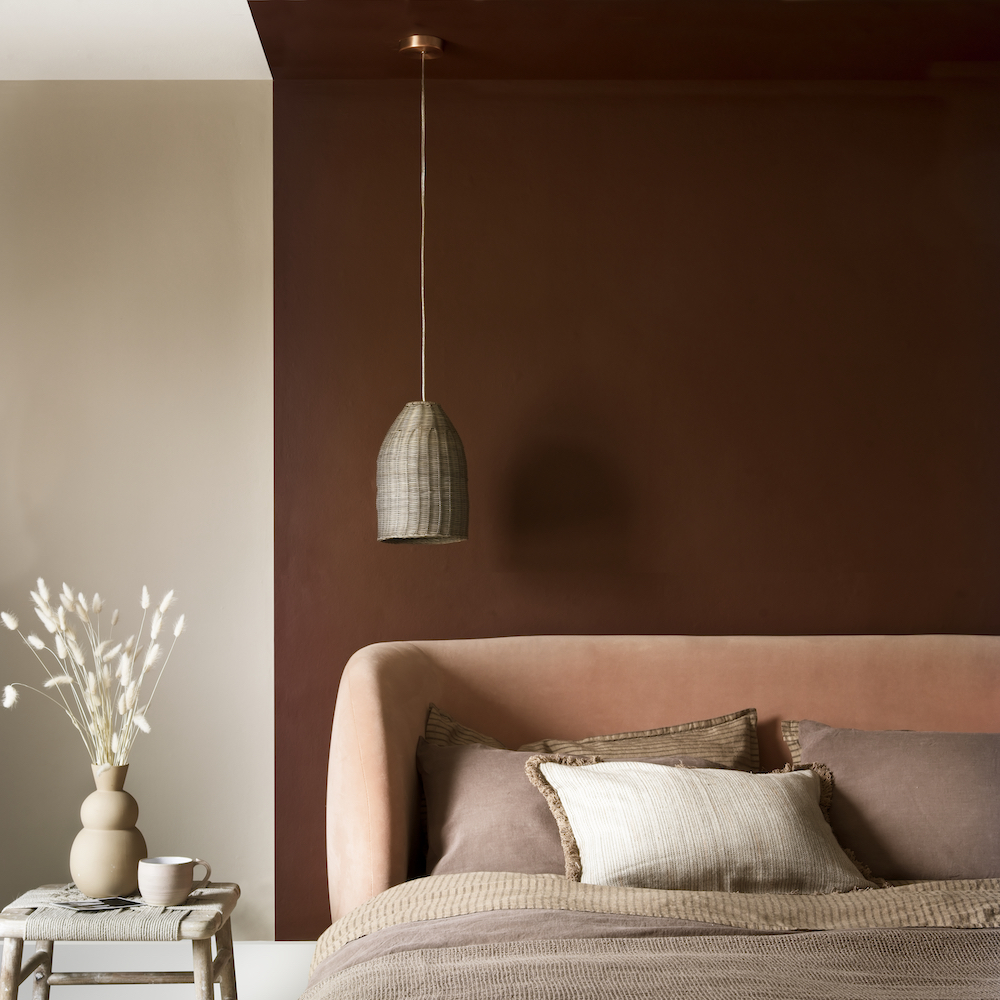
Take a statement headboard to a whole new level. Continue a painted area behind the bed, over and onto the ceiling surface when planning how to paint a ceiling. The painted panel creates a canopy of colour for a cocooning effect.
Use chocolate, coffee and caramel tones for a bedroom scheme that is both warming and restful. Mix velvets, slub linens and textural cottons to add to this welcoming scheme.
26. Frame a vanity area with a painted arch
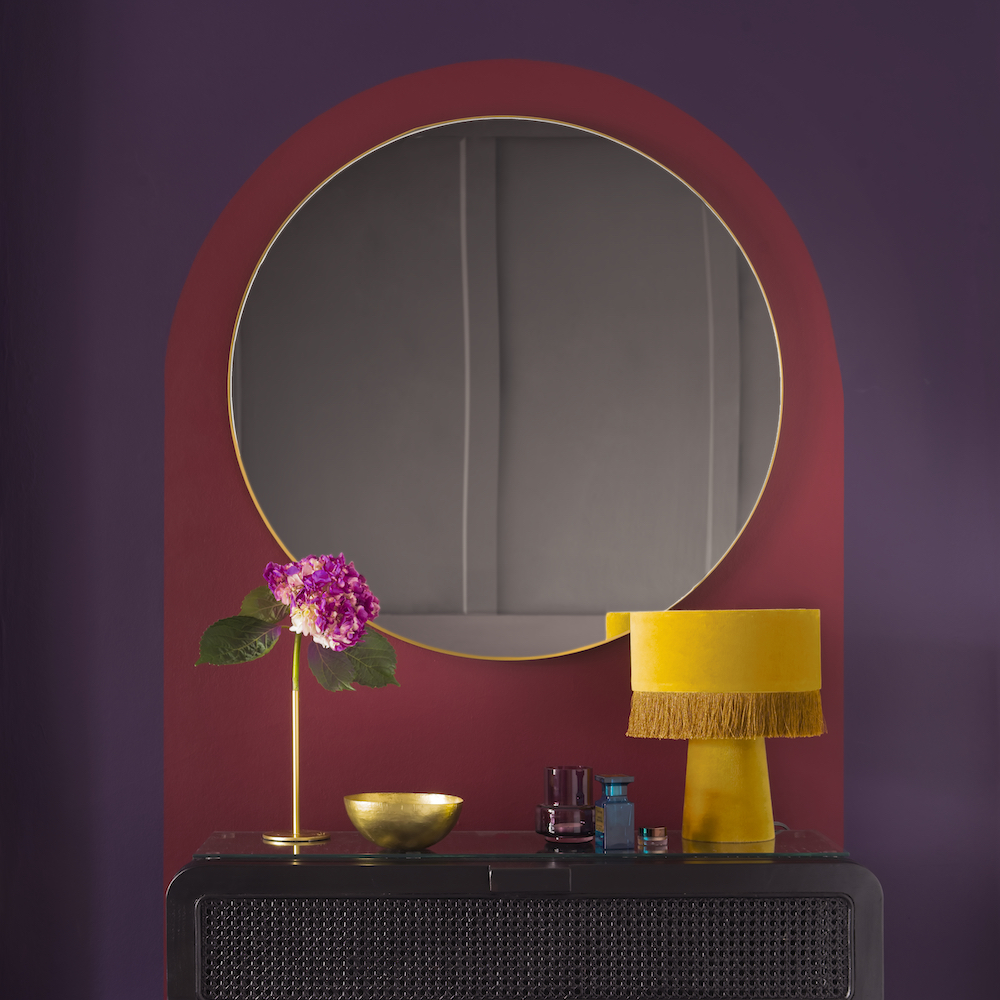
Paint a panel in an accent shade to give the impression of wall architecture where there is none. This also makes a look-at-me feature in a room where there isn't a natural focal point.
Use a painted arch to emphasise a feature, like this oversized circular mirror over a dressing table for a bedroom paint idea. It elevates the room and gives it a boutique hotel feel.
27. Highlight architectural details with colour blocking
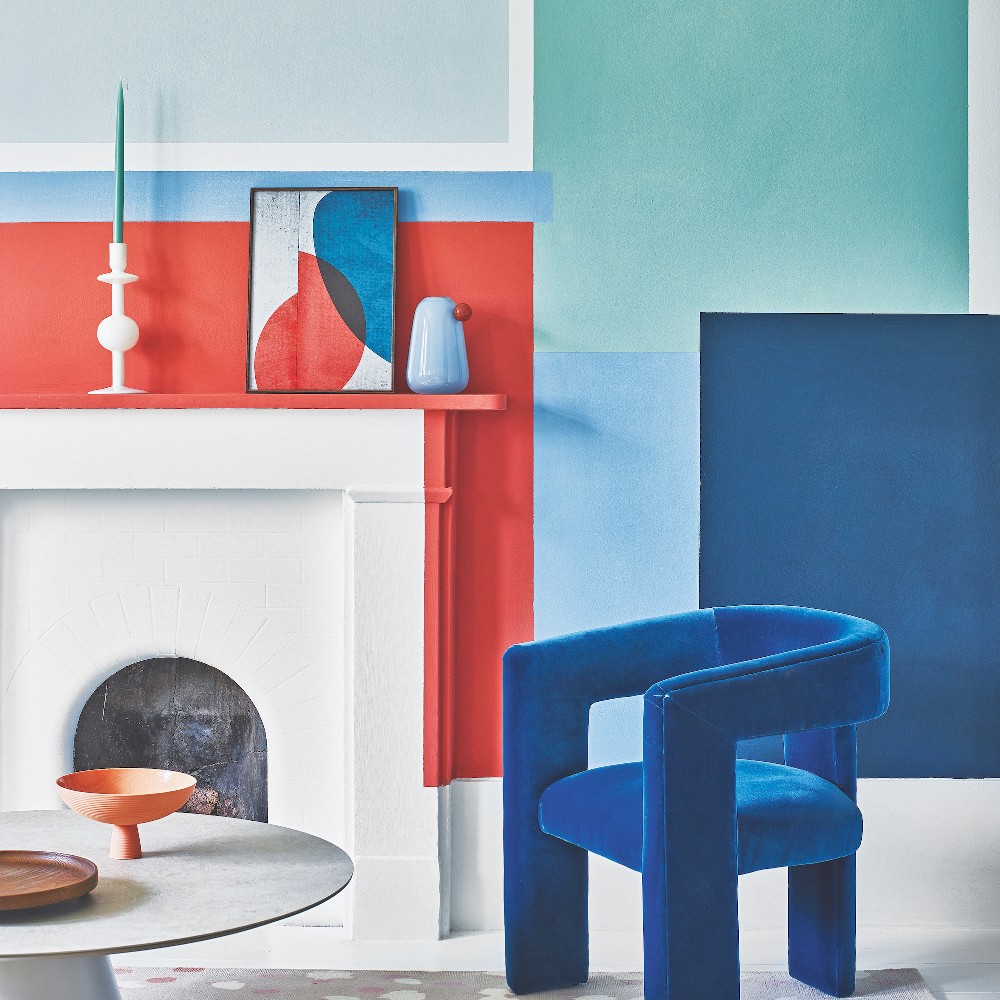
Paint colourful blocks so that they break into a fireplace, or continue over a section of coving, or door architrave. This is a clever paint idea that gives a real designer look to a room.
Choose between three or four shades of paint in striking contrasting colours for a bold statement. Or go for subtler pastel shades for a more soothing scheme. Make sure you cut in paint using masking tape and a set of good brushes.
Try using large circular shapes, or arch shapes as an alternative to rectangles and squares. Remember to choose furniture and accessories that have bold and sculptural forms. They'll sit more comfortably with this eye-catching technique.
28. Paint walls using a scallop stencil
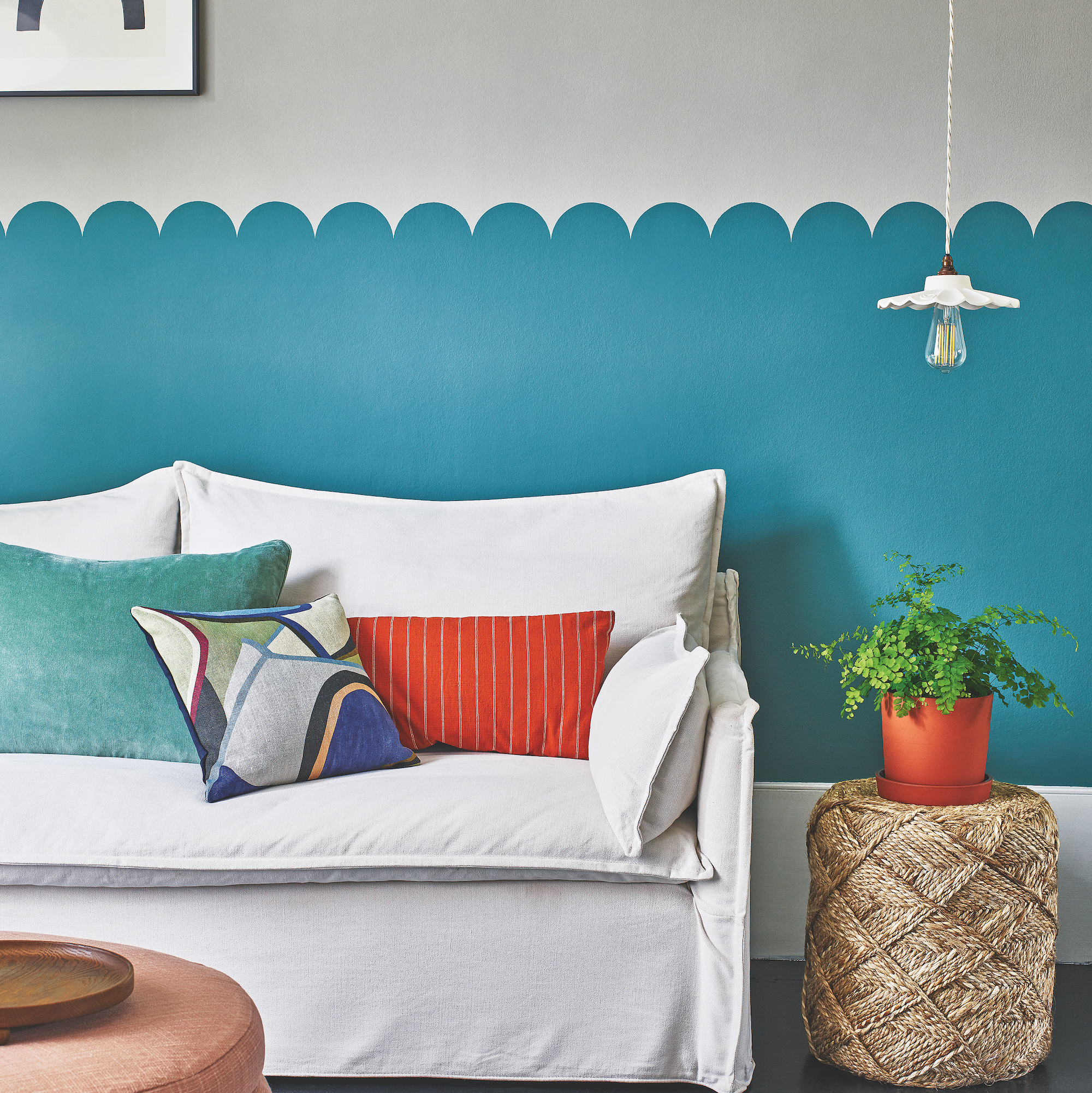
For the most up-to-date living room paint idea, look no further than simply painting a scalloped shape motif along the length of a wall. Ever wondered how to paint a scalloped wall – well it's super easy!
Start by painting the top section of the wall, extending down slightly further than the line you want your scallops to fall at. Then paint up towards the scallop stencil in your base colour, carefully painting up into your stencil shape as you go.
Change the scale of the stencil to alter the effect. A smaller scallop will create a pretty country feel, whilst an oversized stencil will give a bolder, more contemporary look.
29. Add drama to panelling with bold stripes
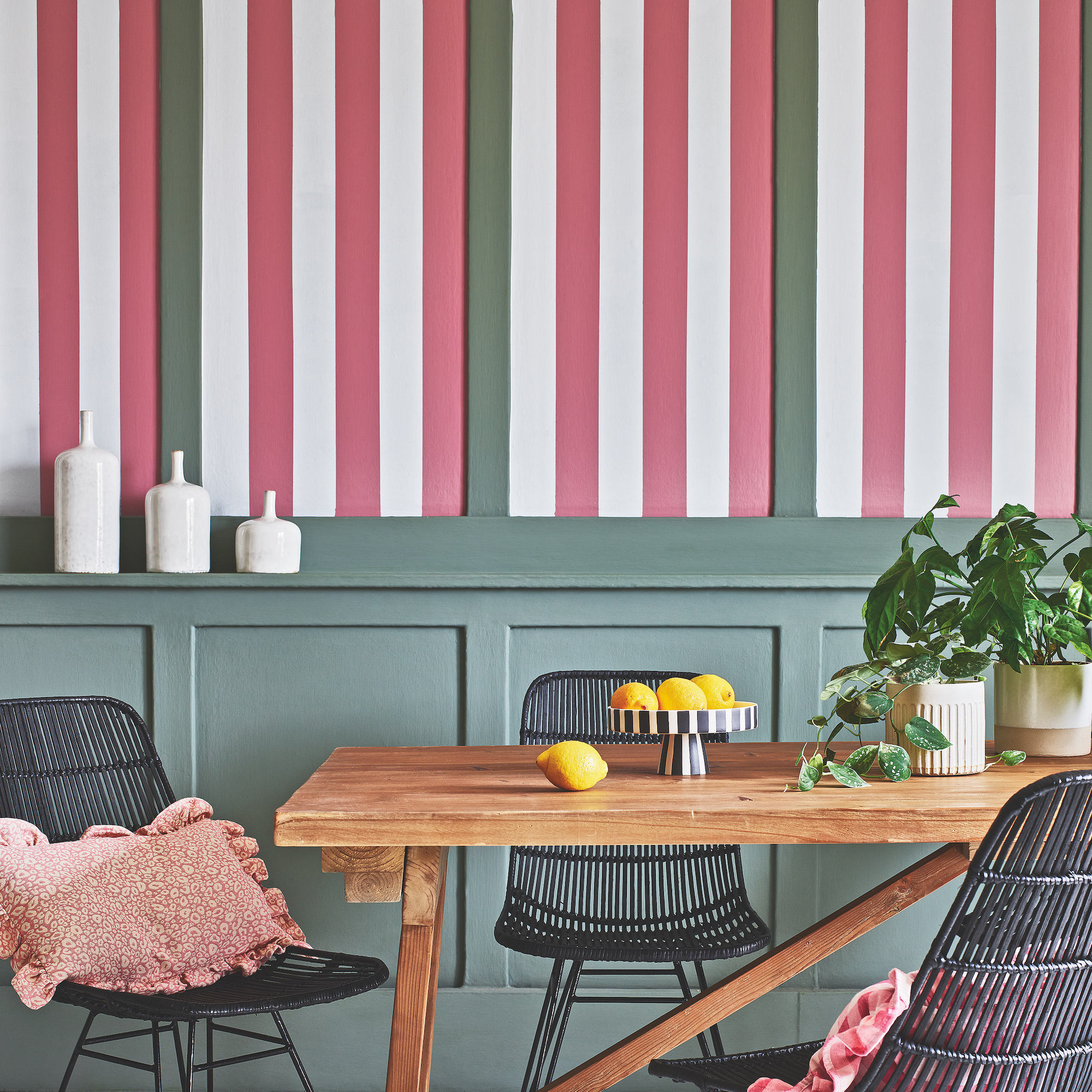
No need to splash out on expensive wallpaper when a couple of paint tester pots will give you the same look for half the price. Creating fun bold stripes is a super quick wall panelling idea. First, paint the inside of the panelling white and then mask off areas to paint in the rose-pink stripes on top.
Keep the furniture simple with a wooden trestle table and black woven chairs, so that the stripes are the star of the show. You could try other wallpaper designs that can be duplicated by using paint – like terrazzo, polka dots or checks.
30. Create a two-tone artwork
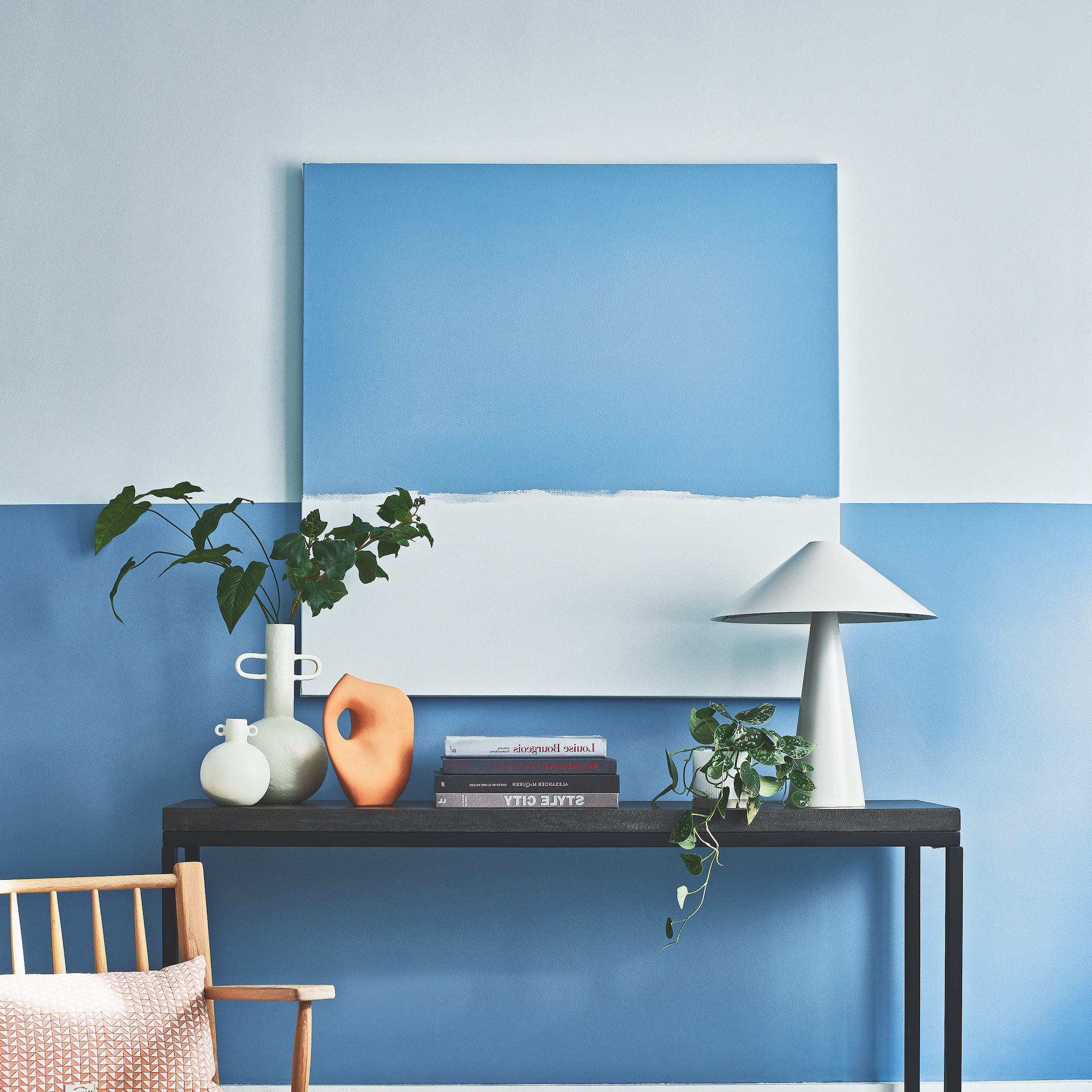
First, paint a two-tone wall and then using the leftover paint from the walls make a reverse-out masterpiece. All you need to do is paint two thirds one colour and one third the other (in the reverse to the colours you have on the wall). Hang so that the dividing lines line up!
Alternatively, use contrasting colours to your wall colour. Pick two shades of terracotta, for example, to make an even bolder art statement.
31. Balance the room using two-tone walls
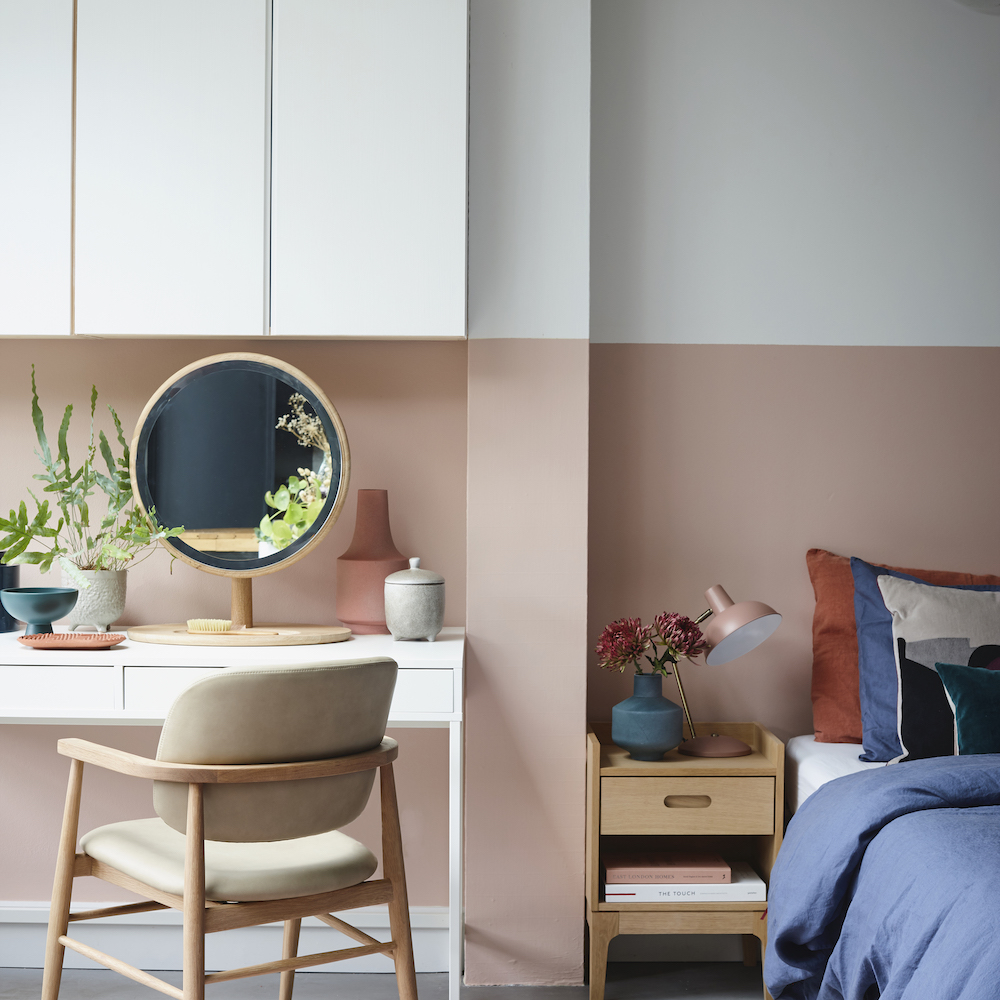
Splitting a room in half using colour will make it feel cosier without dominating and keeping the top half white will give the appearance of height. Painting the bottom half a soft shade will act as fun DIY headboard idea and save on budget too.
Take the two-tone effect all around the room including any architectural features such as architrave and even doors. Here the colour changes along the bottom line of a row of cabinets, it's the perfect trick to make storage blend.
We recommend masking tape - like this Frog Tape from Amazon - to help achieve the perfect clean line when painting with two different colours.
32. Add a subtle slice of colour to divide open-plan living
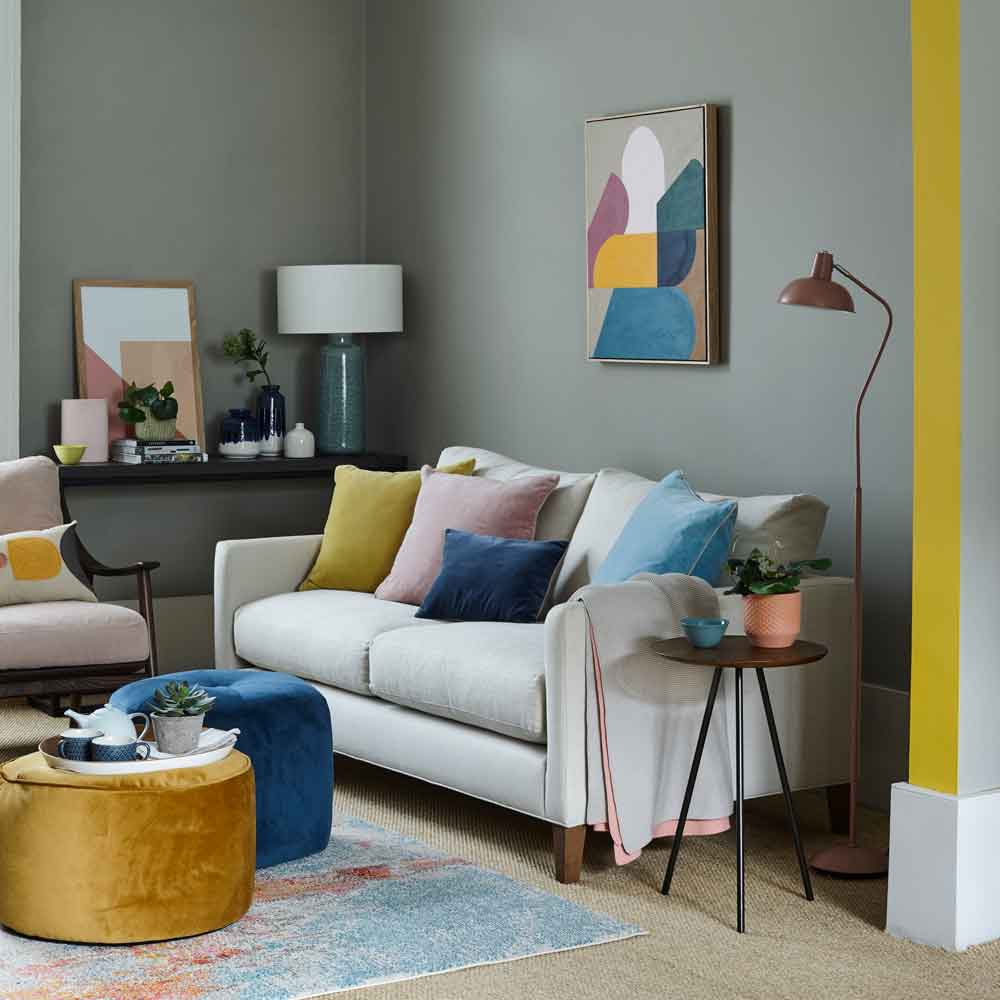
Open-plan living is hugely popular thanks to benefit of making smaller rooms feel bigger and creating a more inclusive space. While it makes sense to paint the original spaces in the same colour, to provide a sense of continuity, it does present the problem of not having defined zones for different activities.
A great way of subtly zoning distinct living areas within the same open-plan living room idea is by adding accent colours on architectural points of interest – such as archways.
Given it's only a limited slice of paint coverage you can afford to change the colour seasonally, or when you switch up accent accessories within the room without huge expense.
33. Stencil a rug onto the floor
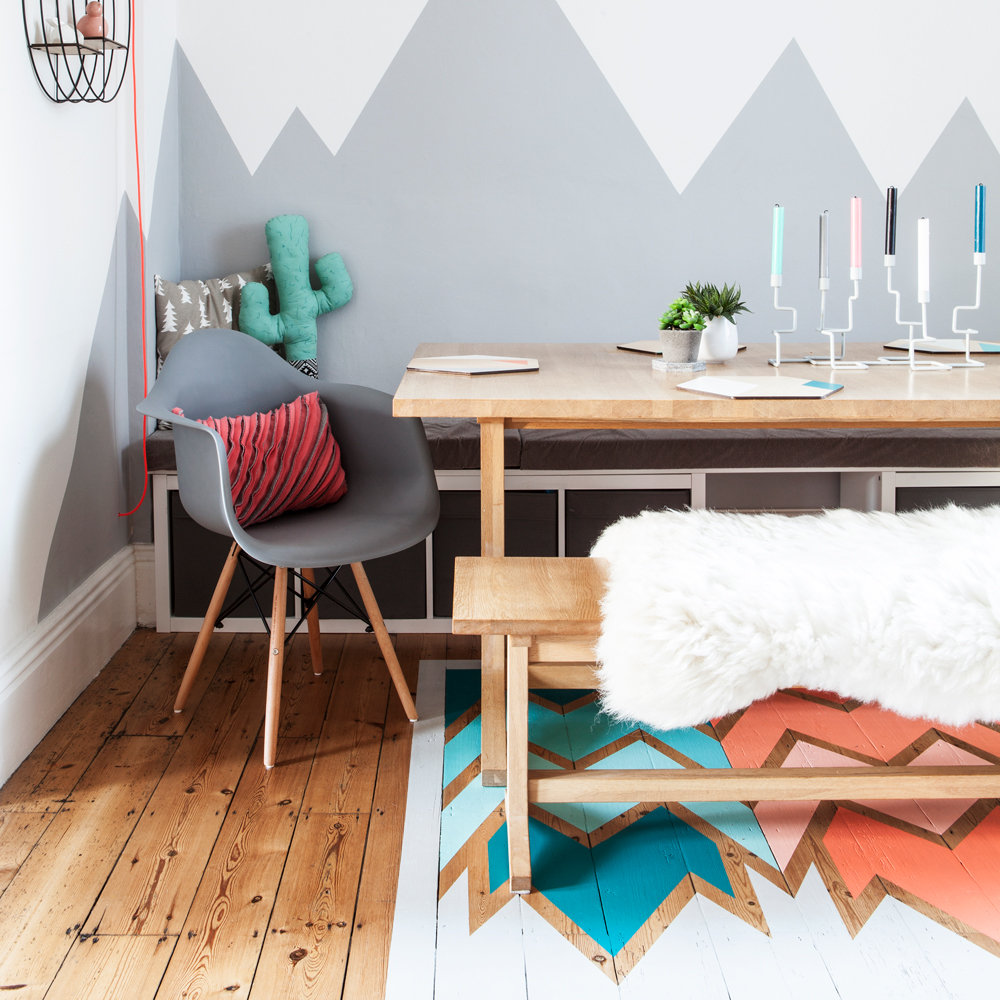
If you can't find the perfect rug to suit your space why not try painting one instead? If you have wooden floorboards the decorating world is your oyster. Use specialist floor paint to fashion a rug design when planning how to paint floorboards. It adds a unique decorative touch for any room with wooden floors.
Here we see a geometric chevron design skillfully painted in an array of bright blues and corals with a pale grey border. Painting a rug is ideal in rooms with high traffic, such as kitchens and hallways because there's no danger of slipping – unlike on the real thing.
To adopt this imaginative idea we suggest planning your design first, measuring the space and marking it out with tape ready to paint. Paint as many coats as necessary, be mindful not to make it too heavy as this is more likely to get scratched. Ensure you allow the colour to dry thoroughly before you place furniture back – lifting, not dragging to avoid scratching the surface.
34. Fake architectural details
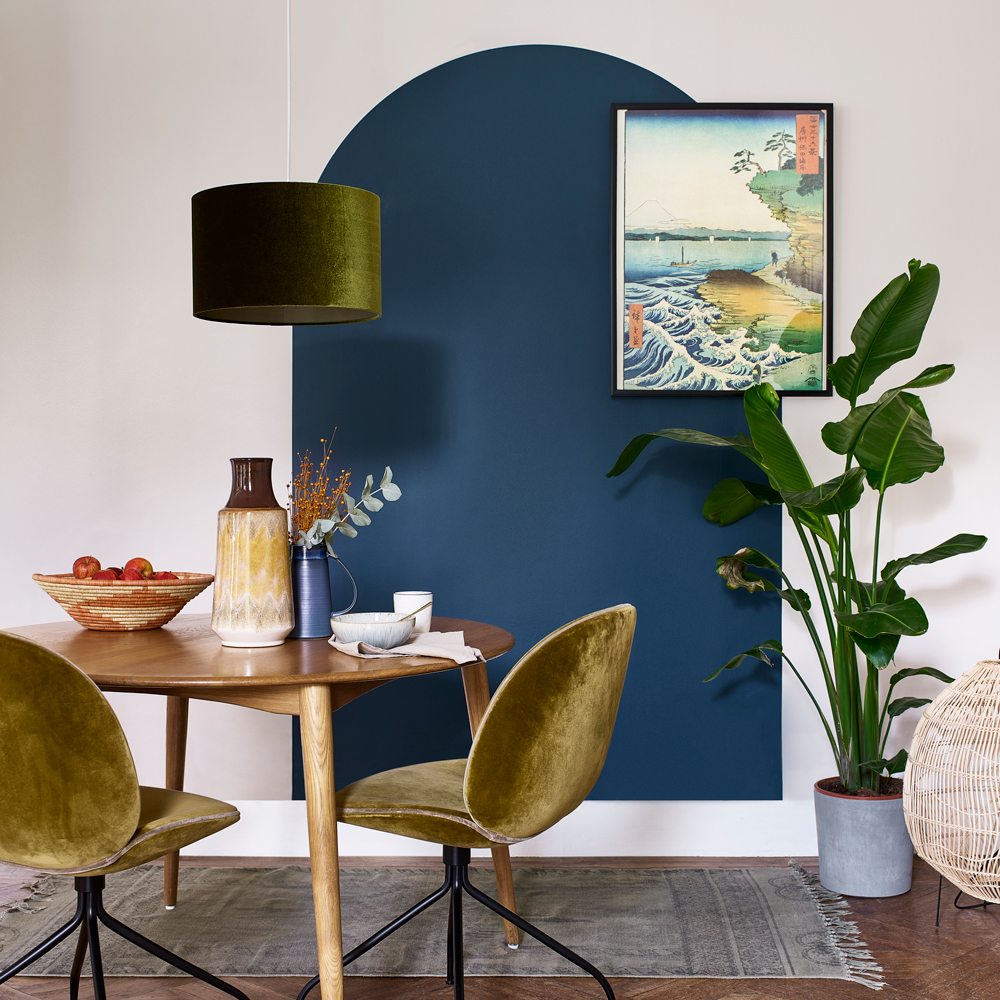
Don't let architecture stand in the way of your design dreams – what is it they say, fake it until you make it! Create the illusion of alcove or archway with a clever application of paint. Simply measure out your design and type with a masking tape, then carefully apply your accent colour to create interest.
'Create a cocooning effect for intimate dinner parties, with a rich-coloured feature wall, like this arch painted in Dulux Simply Refresh Ink Well,' Marianne at Dulux suggests.
35. Pick out a picture rail
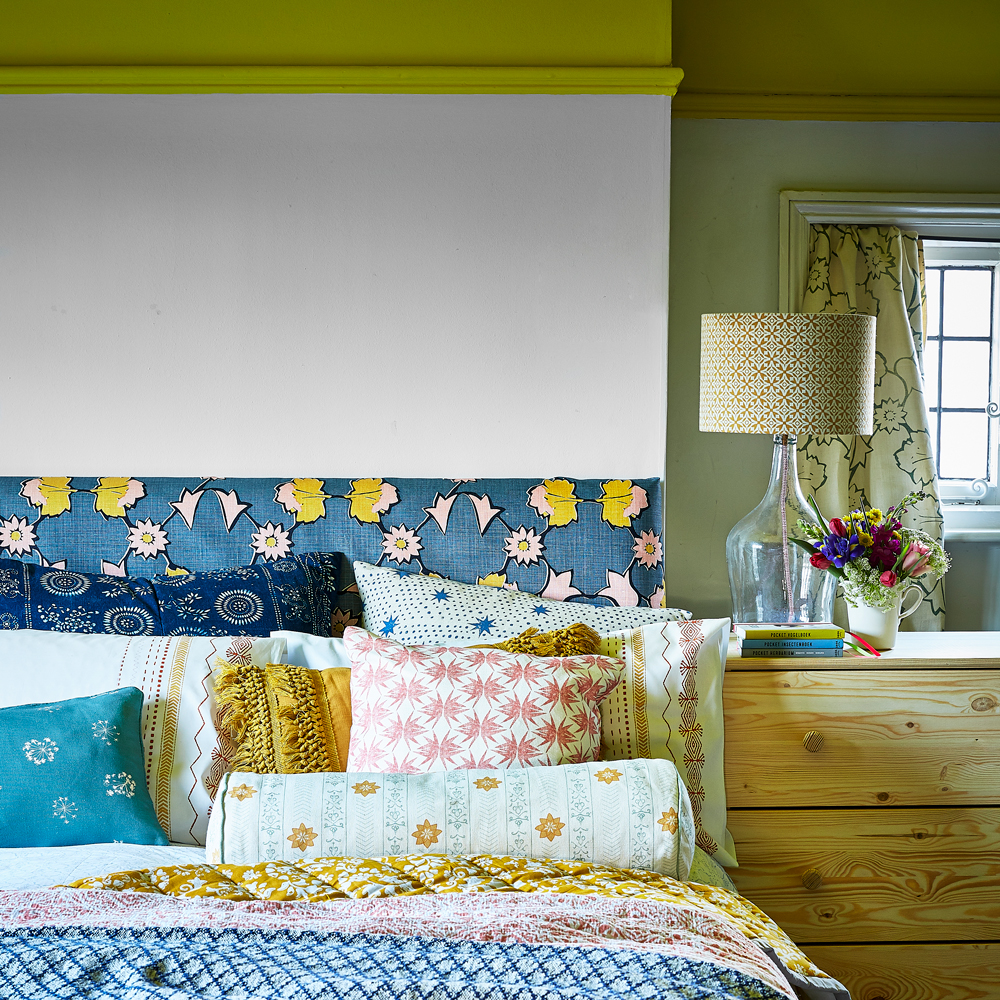
Create the illusion of ceiling height by painting above a picture rail. This simple, yet clever splash of colour helps to draw the eye up, stretching the walls up. It works best with bare walls, rather than decorated with wallpapers and pictures. Choose a bright colour to make even more of a statement.
36. Frame architraving with colour
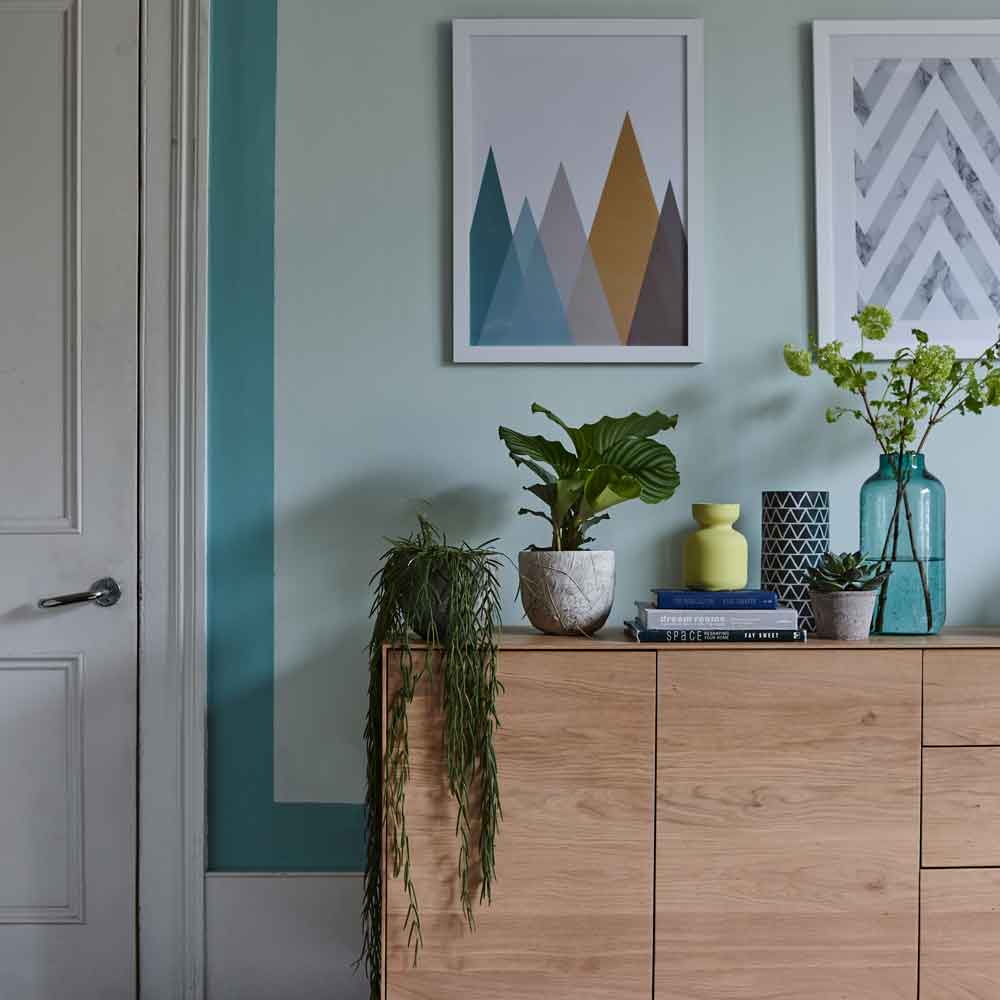
Draw attention to decorative woodwork such as doorframes and cornicing by picking it out in an unexpected colour (not white!) and carrying the colour further up the wall to give the illusion of depth. Pick a striking, contrasting shade to add pops of colour around the room by painting a chair or a lamp base in the same paint.
This idea helps to break up a solid expanse of painted wall, while adding an uplifting accent colour in the room scheme. You could also consider colour as an option when looking at how to paint skirting boards.
FAQs
What changes can I make with paint?
'Painting a room in contrasting colours is a great way to create a dynamic space with plenty of personality,' says Judy Smith, Crown colour consultant. 'Whether drawing a geometric shape on a bare wall or highlighting features such as radiators, skirting boards and window frames with colour. Using contrasting shades will add a playful and quirky feel.'
'Versatile and impactful, the effect can be achieved by mixing bold and neutral shades, creating a variety of moods that will suit different styles of interiors.'
'Contrasting colours can be introduced in a number of ways. Use natural breaks such as corners, alcoves, shelving, dado or picture rails to start and stop the different colour choices,' Judy advises. 'Alternatively, a simple and effective way to use different shades is to paint up to a certain level in one colour, mask with tape and then paint above in a different shade.'
Whether looking to add architectural detail for a thoughtful dining room paint idea or creating a striking contrast with a dark ceiling as part of a bedroom paint idea, there's an imaginative solution for every room.
And, of course, paint isn't just limited to the walls, use the best paint for furniture to add a splash of colour to an old dining table and chairs, sideboard or chest of drawers.
Is it cheaper to paint or wallpaper a room?
Both wallpaper and paint can range in price from low to high but generally wallpaper is more expensive to purchase. Wallpaper often needs an expert to install it, whereas paint is on average a cheaper option and doesn't need an expert to apply it.
Should I use a brush or a roller to paint walls?
A roller is much quicker to cover large areas but will give a slightly stippled effect due to its foam or wool finish, whereas a paint brush will give a smoother finish. You may find that rollers can cause a small mist of paint to spray around the room, so more care needs to be taken with covering furniture and flooring, than with a brush where you can control the paint a little more.
Always use brushes to cut in the edges before filling in the main area with a roller as rollers cannot get into corners easily. It's quicker to wash and clean brushes than rollers, due to the fact they do not absorb as much paint.
Which paint idea are you going to try out in your home next?







